Lecture 20smt: Science and Pseudoscience in Clinical Psychology
1/91
There's no tags or description
Looks like no tags are added yet.
Name | Mastery | Learn | Test | Matching | Spaced |
|---|
No study sessions yet.
92 Terms
What do clinical psychology and allied disciplines house? (The Scientist-Practitioner Gap)
Two largely disconnected worlds:
Researchers and practitioners who ground their work largely in scientific evidence.
Mental health professionals who routinely neglect research evidence.
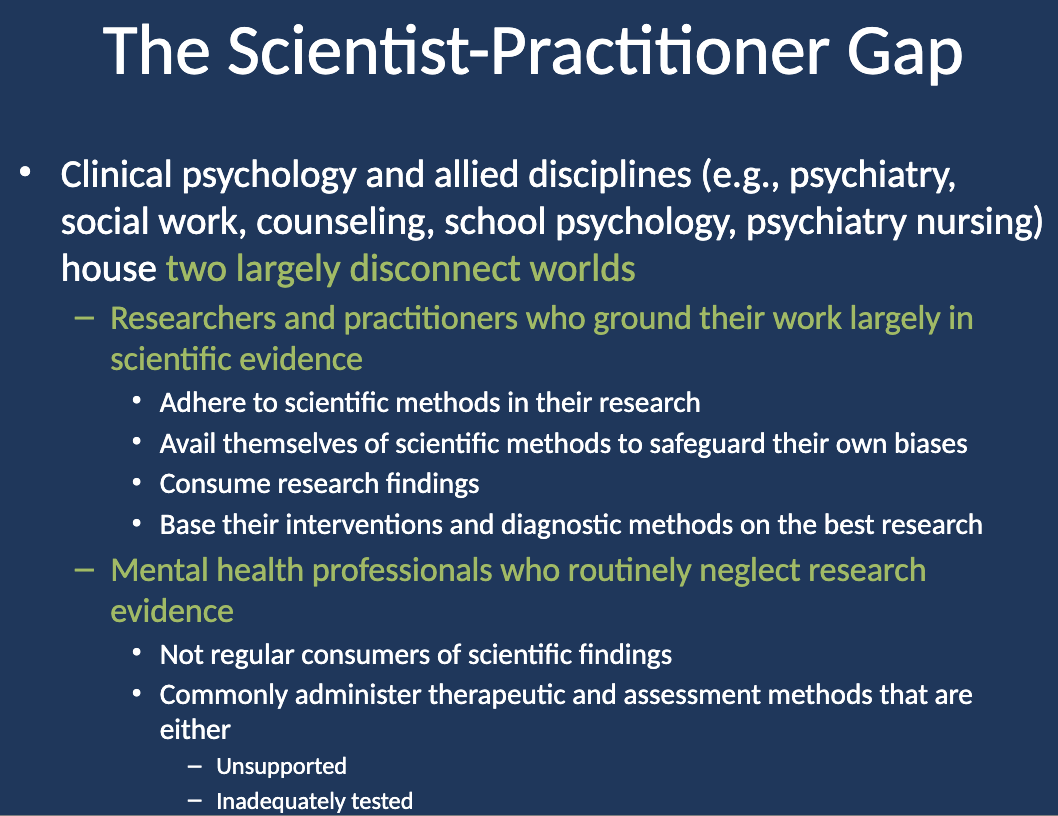
What are the two largely disconnected worlds in clinical psychology and allied disciplines? (The Scientist-Practitioner Gap)
Researchers and practitioners who base their work on scientific evidence.
Mental health professionals who often neglect research evidence.
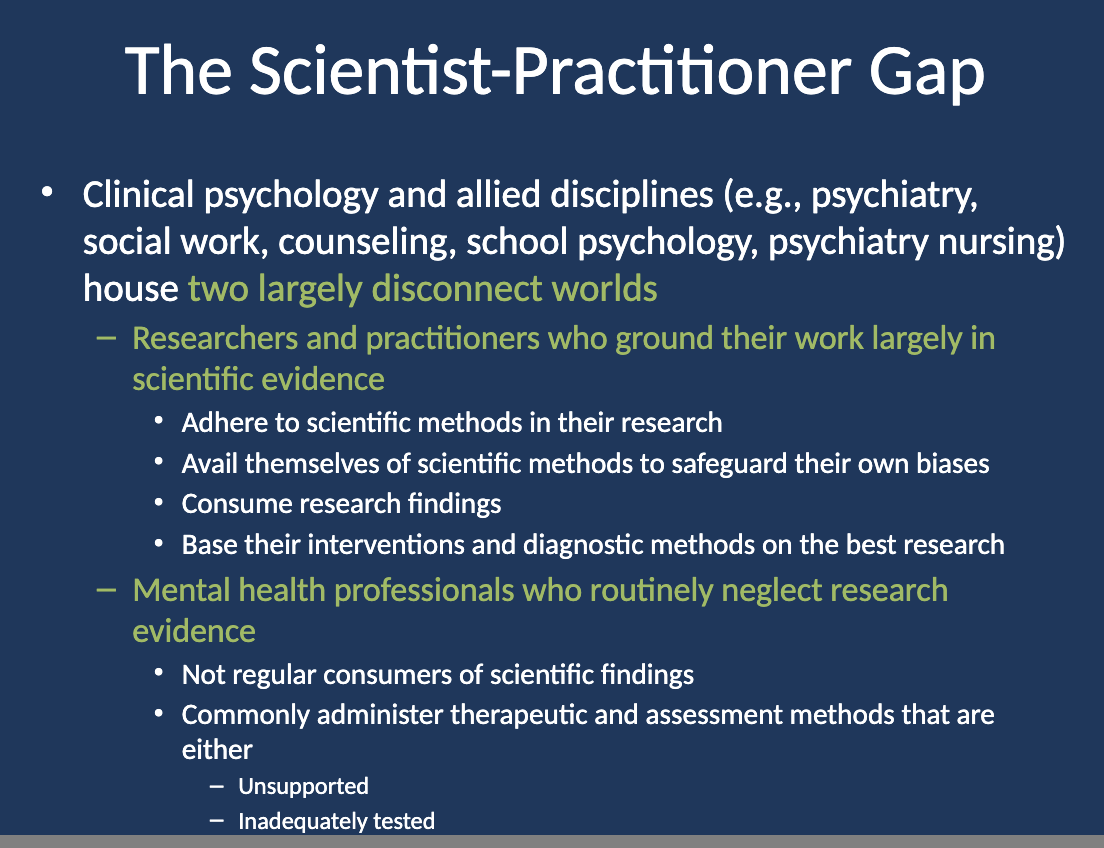
Who are the researchers and practitioners that ground their work in scientific evidence? (The Scientist-Practitioner Gap)
They adhere to scientific methods in their research.
They use scientific methods to safeguard against biases.
They consume research findings.
They base interventions and diagnostic methods on the best research.
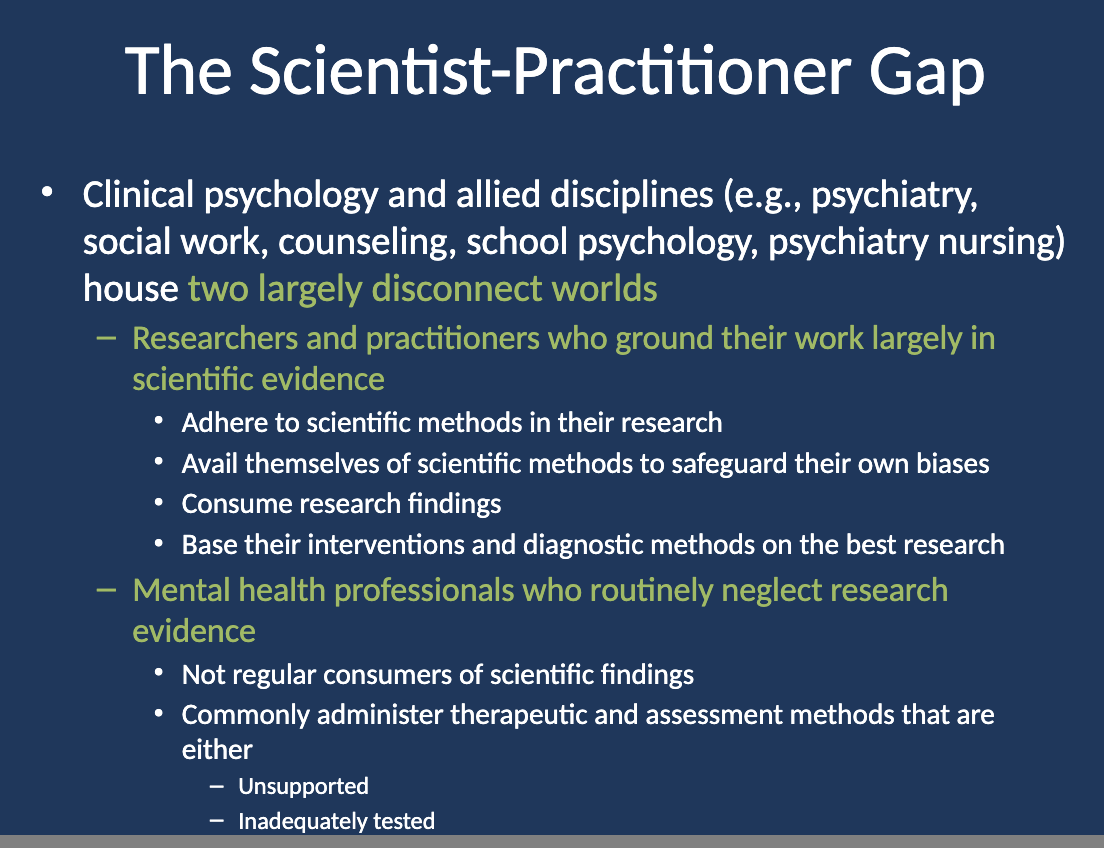
Who are the mental health professionals who routinely neglect research evidence? (The Scientist-Practitioner Gap)
They are not regular consumers of scientific findings.
They often administer therapeutic and assessment methods that are unsupported or inadequately tested.
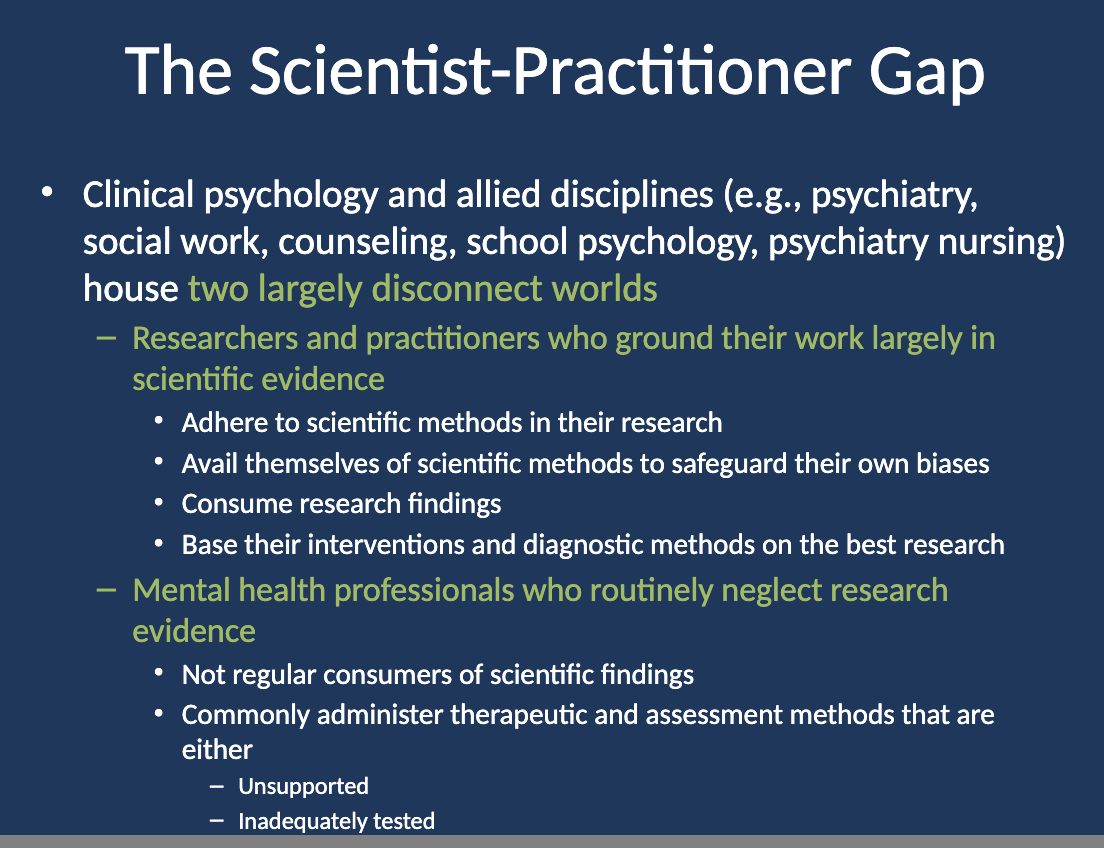
What has been the change in the relation between science and practice in clinical psychology? (The Scientist-Practitioner Gap)
A growing minority of clinicians now base their therapeutic and assessment practices primarily on clinical experience and subjective intuition rather than controlled research evidence.
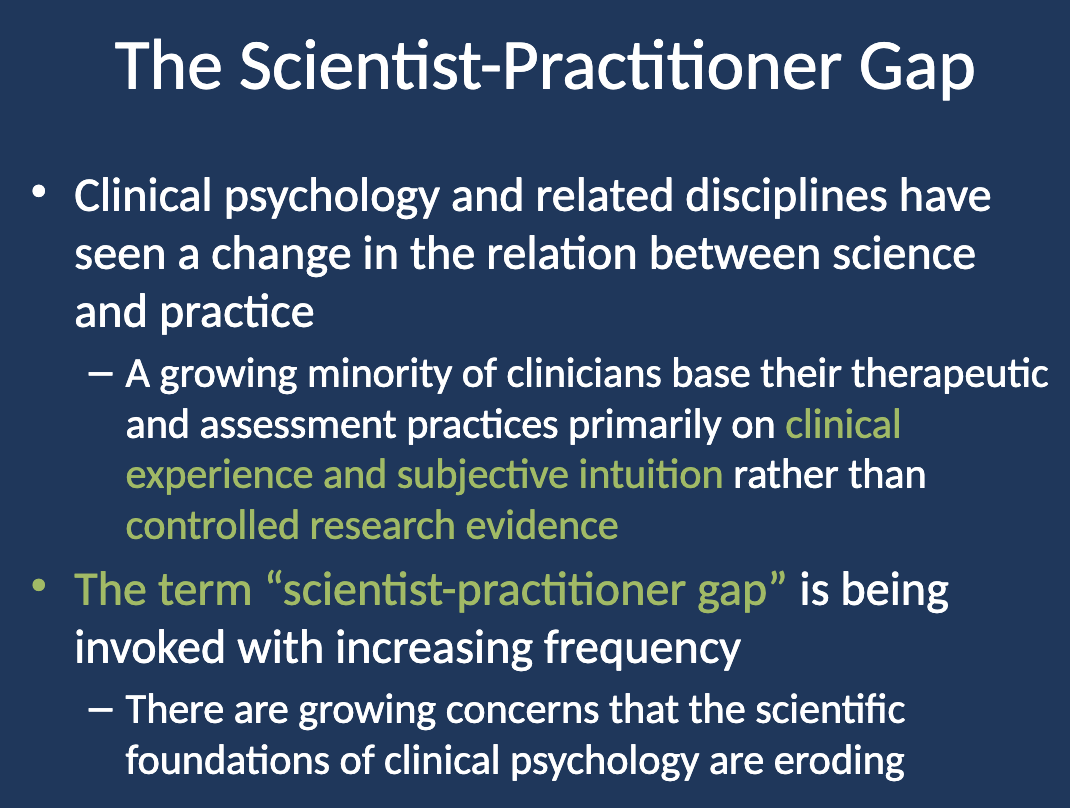
What does the term "scientist-practitioner gap" mean? (The Scientist-Practitioner Gap)
It refers to the disconnect between researchers and practitioners in clinical psychology, where scientific evidence is often neglected in favor of clinical experience and intuition.
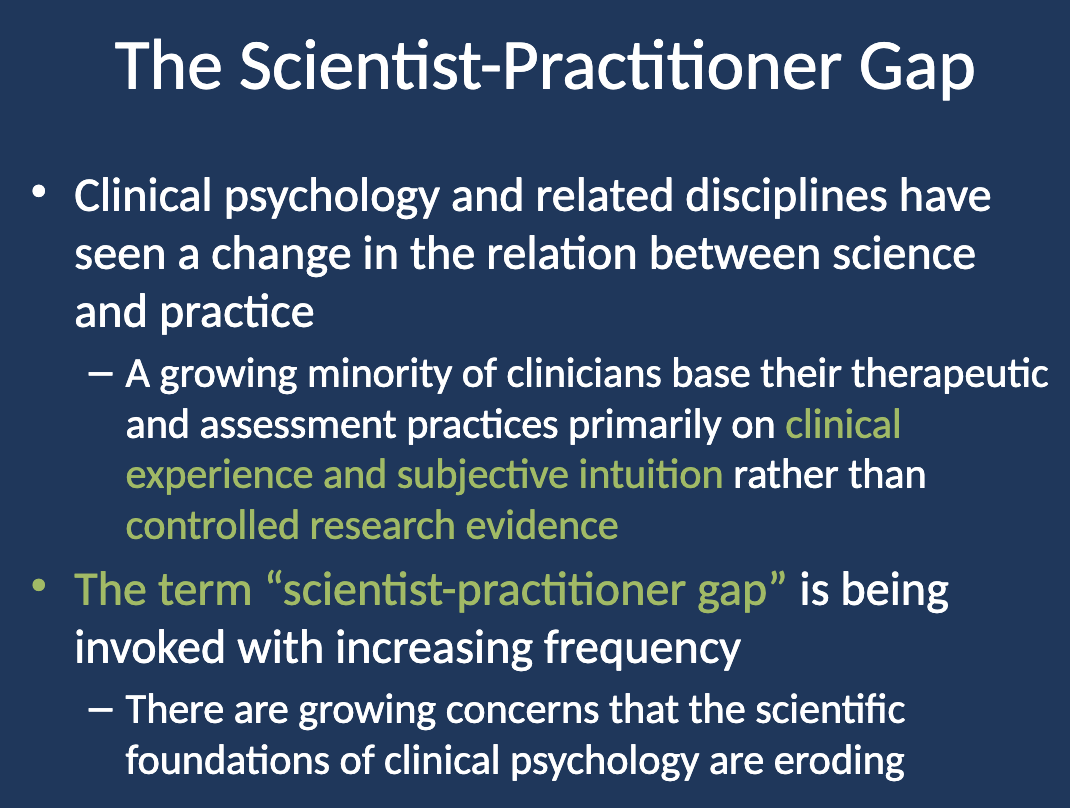
How is the term "scientist-practitioner gap" being invoked more frequently? (The Scientist-Practitioner Gap)
There are increasing concerns that the scientific foundations of clinical psychology are eroding as more practitioners prioritize clinical experience over controlled research evidence.

What did surveys of clinical psychologists and mental health professionals report regarding their use of research evidence? (The Scientist-Practitioner Gap)
Many reported placing more weight on clinical experience, intuition, and theoretical orientation than on controlled research evidence when selecting interventions.
This devaluation of scientific evidence may have harmful consequences for clients.

What are the primary sources of the growing scientist-practitioner gap? (The Scientist-Practitioner Gap and its Sources)
Some practitioners in clinical psychology and related mental health fields continue to use unsubstantiated, untested, and questionable treatment and assessment methods.
Psychotherapeutic methods of unknown or doubtful validity are proliferating almost weekly.
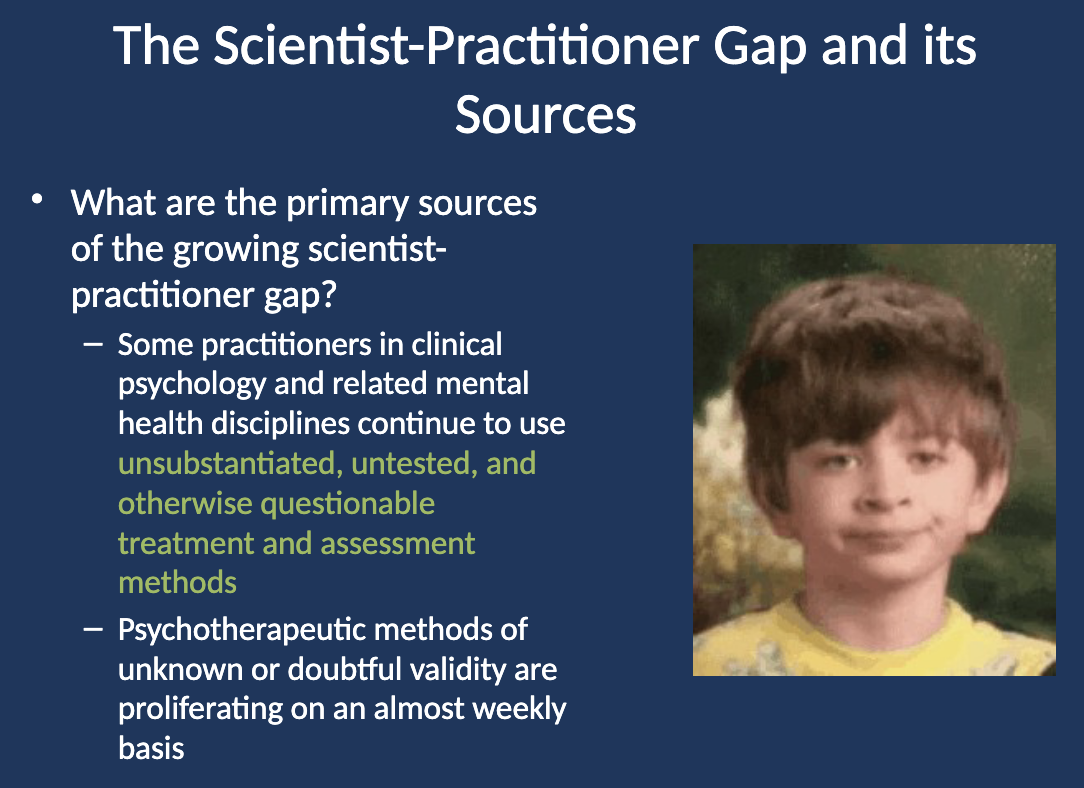
What did the sampling show about fringe psychotherapeutic practices? (The Scientist-Practitioner Gap and its Sources)
A highly selective sampling identified various fringe psychotherapeutic practices, including:
Neurolinguistic programming
Thought Field Therapy
Emotional Freedom Technique
Rage reduction therapy
Primal scream therapy
Feeling therapy
Buddha psychotherapy, past lives therapy
Future lives therapy
Alien abduction therapy
Rebirthing
Sedona method
Silva method
Entity depossession therapy
Vegetotherapy
Palm therapy
And many others.
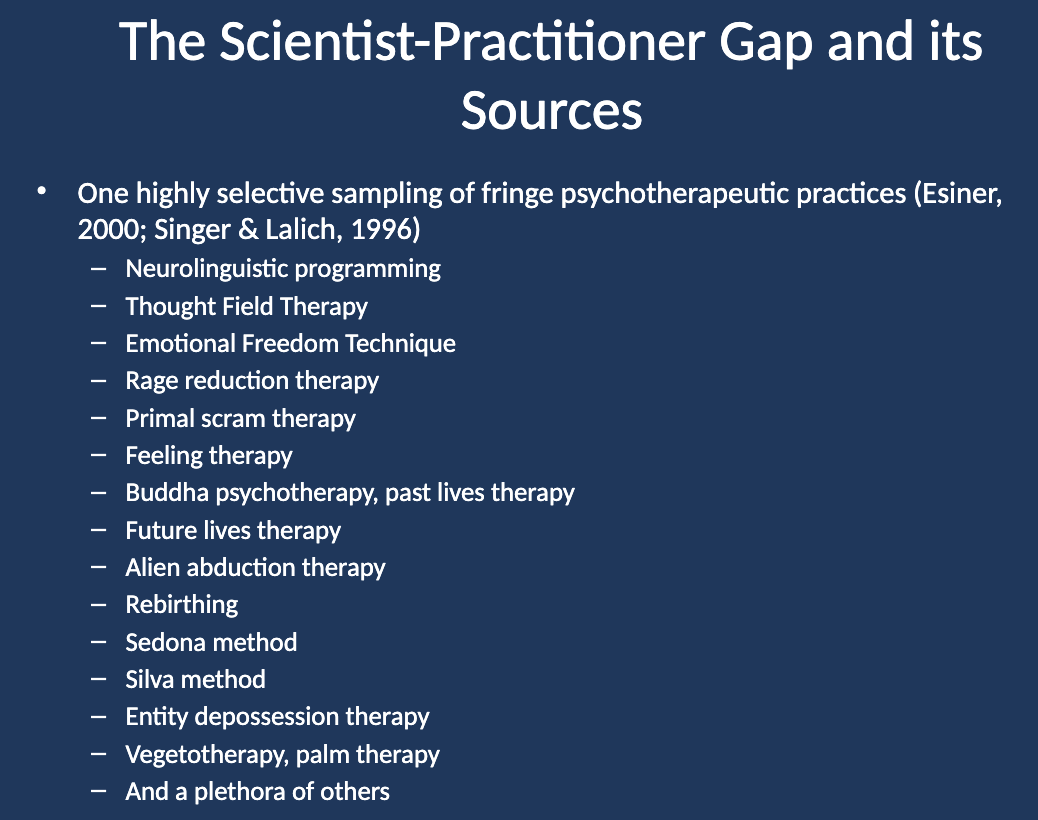
What technique receives minimal scientific scrutiny in clinical psychology? (The Scientist-Practitioner Gap and its Sources)
A range of fringe psychotherapeutic techniques (e.g., music therapy, homeopathy, breath work, aromatherapy, acupuncture) often receive minimal scientific scrutiny despite widespread media coverage.
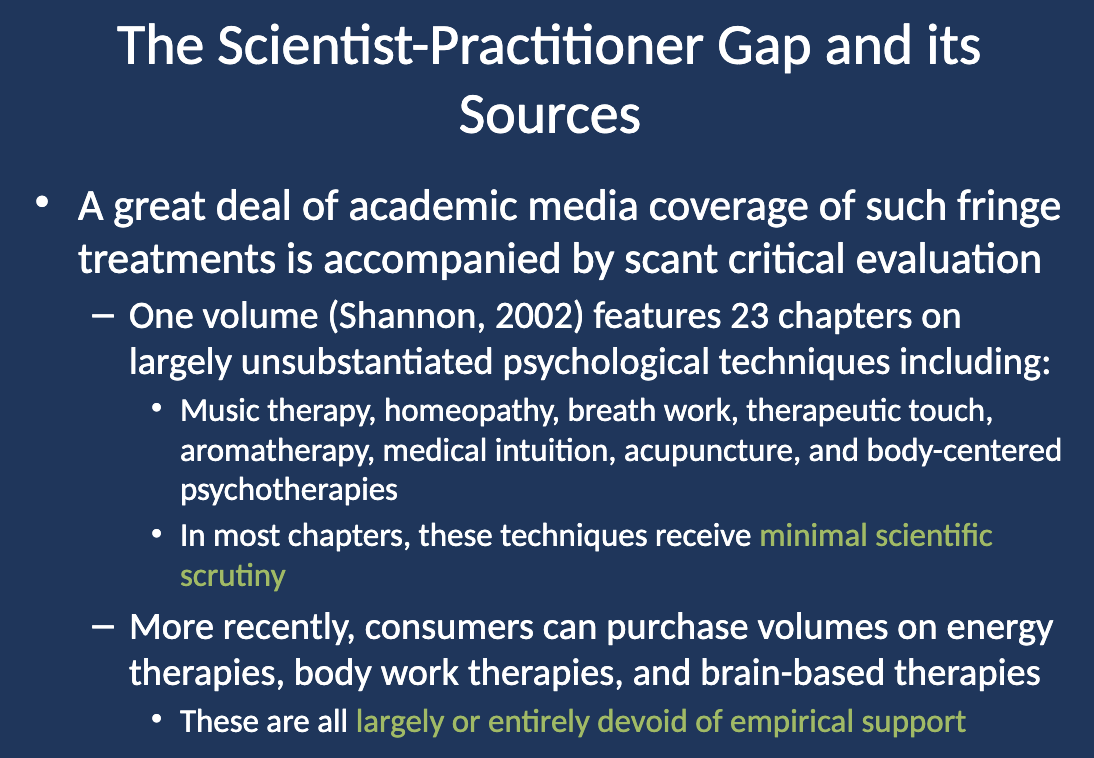
Why do some therapeutic techniques receive minimal scientific scrutiny? (The Scientist-Practitioner Gap and its Sources)
Many therapeutic techniques, especially fringe ones, receive minimal scientific scrutiny due to a lack of rigorous research, limited critical evaluation, and the popularity of unsubstantiated treatments in academic and media circles.
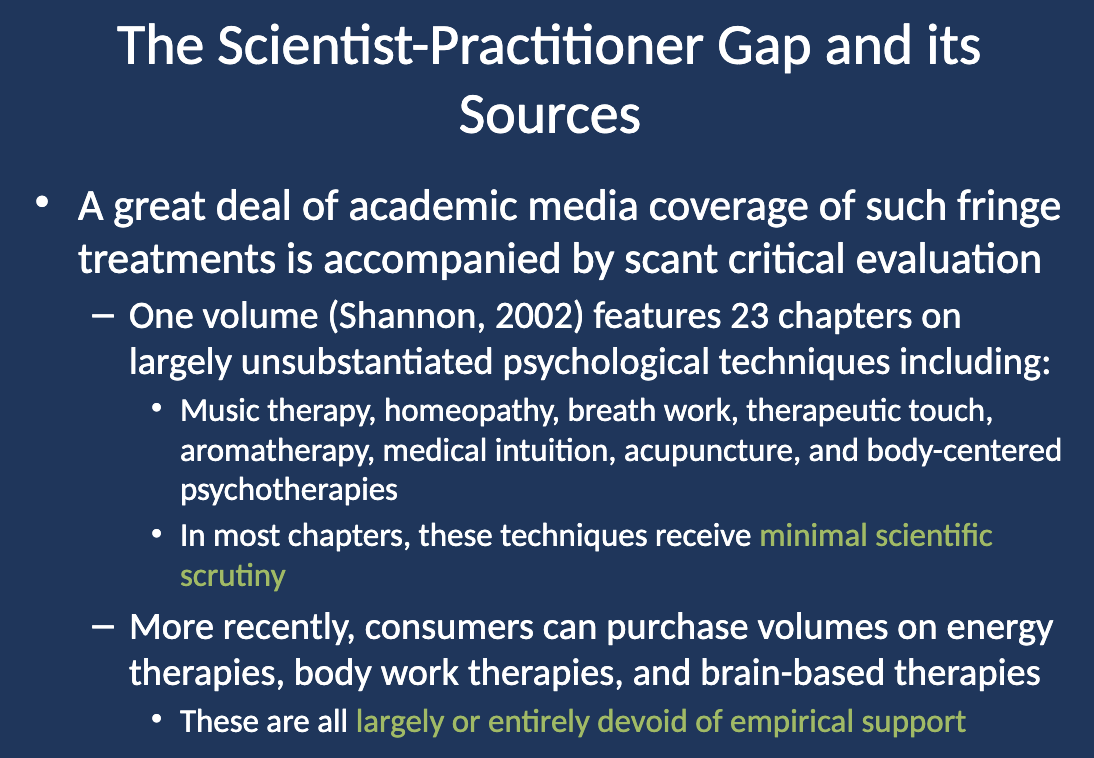
What are fringe treatments in the context of the scientist-practitioner gap? (The Scientist-Practitioner Gap and its Sources)
Fringe treatments refer to untested, unconventional psychotherapeutic techniques that are largely or entirely devoid of empirical support. Examples include energy therapies, body work therapies, and brain-based therapies.
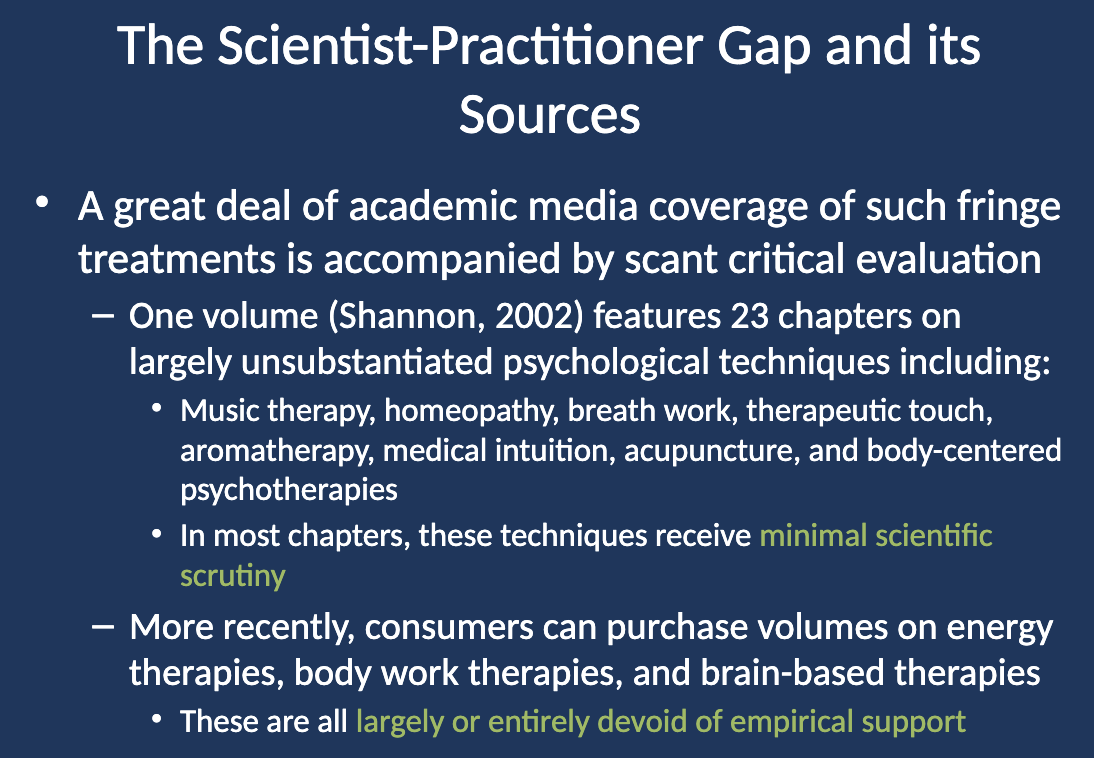
What is devoid of empirical support in clinical psychology and why? (The Scientist-Practitioner Gap and its Sources)
Many fringe treatments and therapies are devoid of empirical support because they are not backed by controlled, scientific research.
These therapies, often highlighted in media and academic volumes, lack rigorous testing, leading to concerns about their validity and effectiveness.
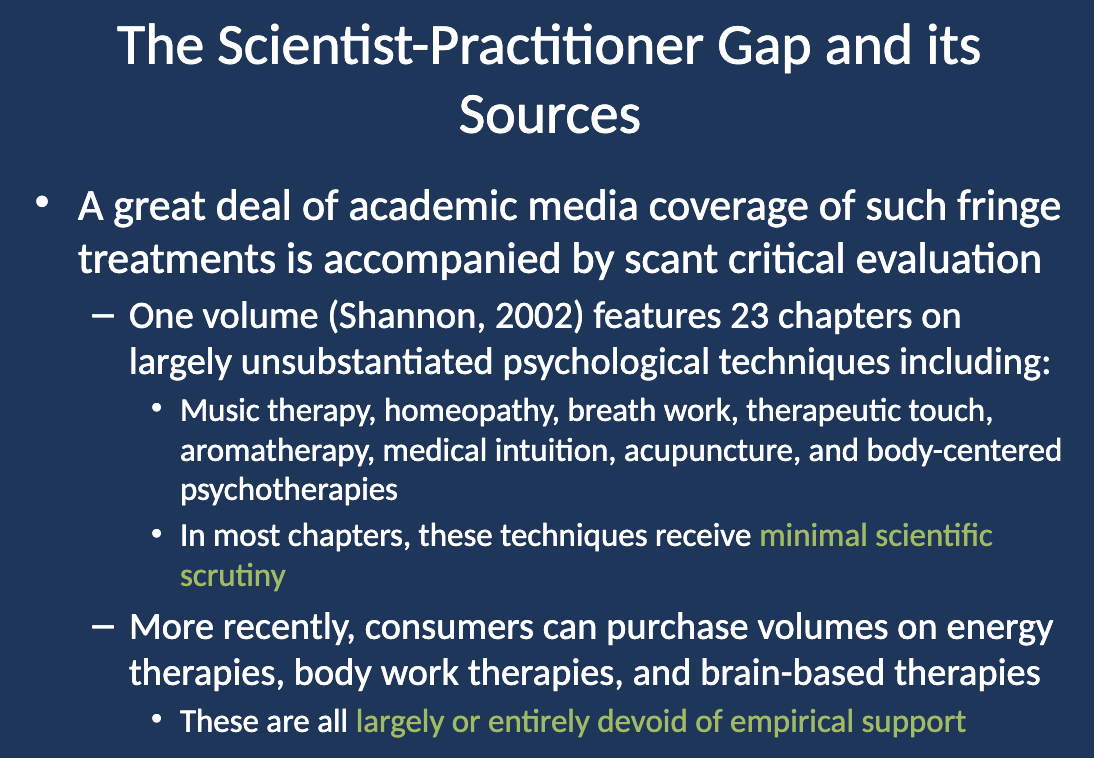
What are additional threats to the scientific foundations of clinical psychology? (The Scientist-Practitioner Gap and its Sources)
The thriving self-help industry, which produces hundreds of books, manuals, and audiotapes each year.
Many of these self-help materials promise quick solutions to complex problems but have never been empirically tested.
Self-help "gurus" on TV and radio often offer advice of questionable scientific validity to a vulnerable audience.

How are some self-help methods efficacious, but the majority are what? (The Scientist-Practitioner Gap and its Sources)
Some self-help methods may be efficacious.
However, the overwhelming majority have never been subjected to empirical scrutiny and lack scientific support.
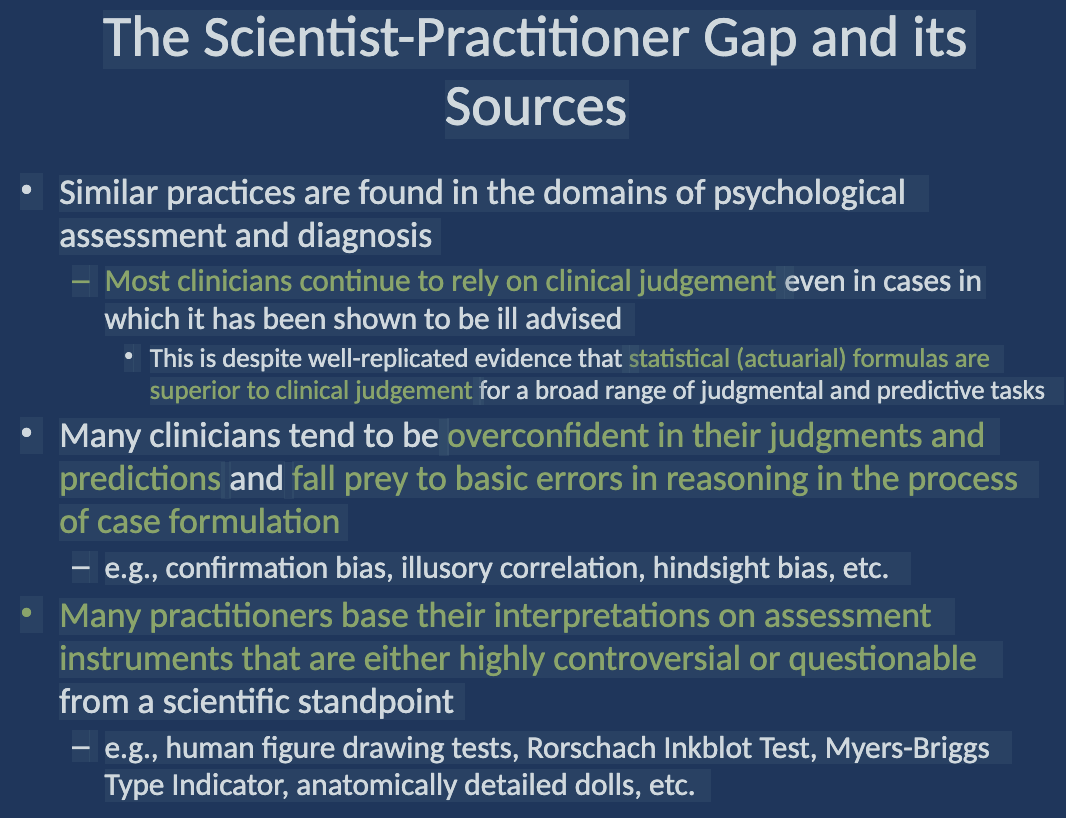
What do most clinicians continue to rely on, even though it has been shown to be ill-advised? (The Scientist-Practitioner Gap and its Sources)
Most clinicians continue to rely on clinical judgment in situations where statistical (actuarial) formulas have been shown to be superior for judgment and prediction tasks.
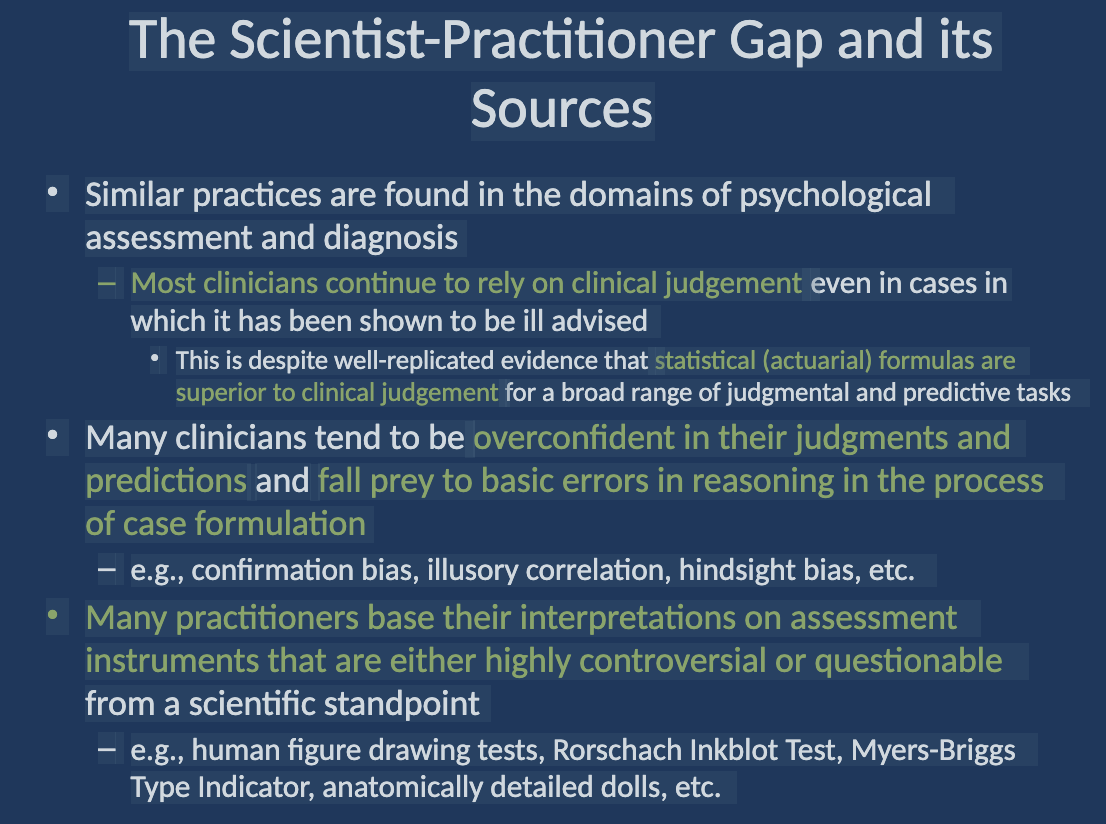
Why do clinicians continue to rely on clinical judgment despite well-replicated evidence against it? (The Scientist-Practitioner Gap and its Sources)
Clinicians often rely on clinical judgment despite evidence showing statistical formulas are more reliable because they may overestimate their own judgment skills and be resistant to change.

What do many clinicians tend to be overconfident about, and what does this lead to? (The Scientist-Practitioner Gap and its Sources)
Many clinicians tend to be overconfident in their judgments and predictions, leading them to make basic reasoning errors like confirmation bias, illusory correlation, and hindsight bias during case formulation.
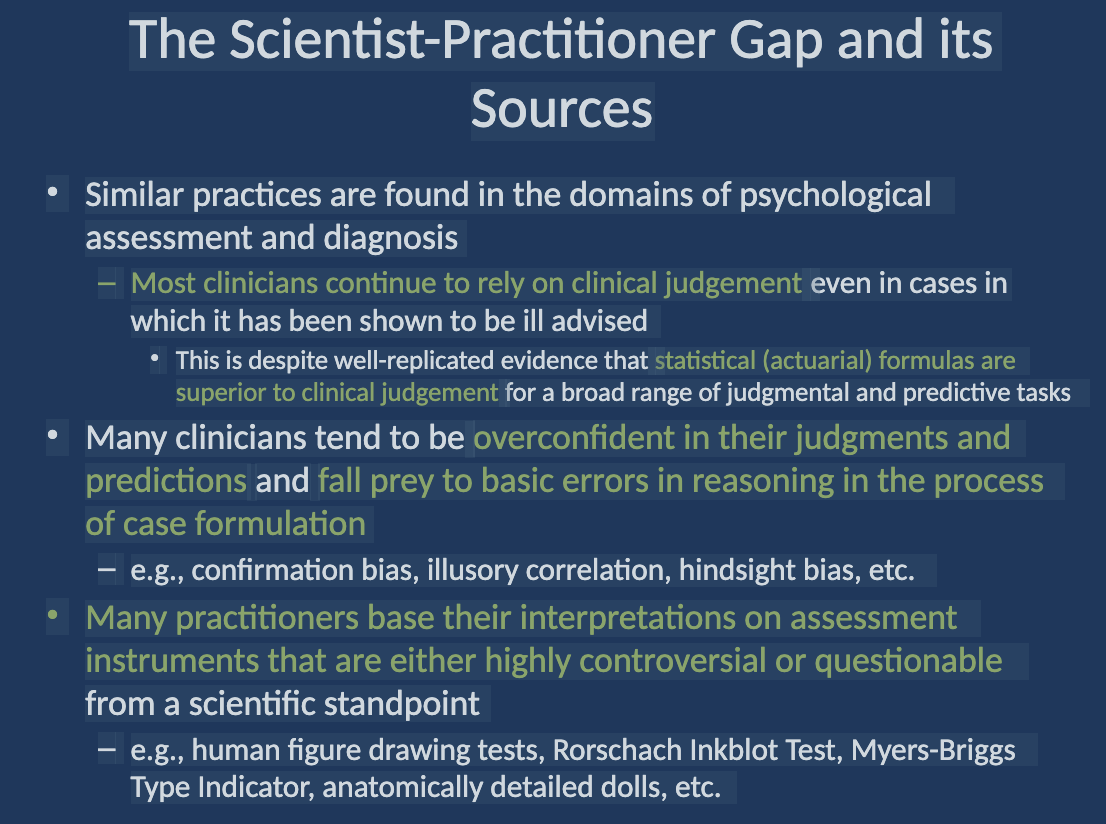
On what do many practitioners base their interpretations that are scientifically questionable? (The Scientist-Practitioner Gap and its Sources)
Many practitioners base their interpretations on assessment tools that are either highly controversial or scientifically questionable, such as:
Human figure drawing tests
Rorschach Inkblot Test
Myers-Briggs Type Indicator
Anatomically detailed dolls

What is the problem with questionable diagnostic labels, and where is it especially acute? (The Scientist-Practitioner Gap and its Sources)
The problem is that psychiatric labels of unknown or doubtful validity are sometimes used inappropriately, particularly in courtroom settings as exculpatory defenses.
Examples include labels like "road rage syndrome," "sexual addiction," and "battered woman’s syndrome."

What should we do regarding largely untested psychotherapeutic, assessment, and diagnostic methods, and why? (Excessive Open-Mindedness or Excessive Skepticism?)
We should avoid being dismissive of untested methods because some may ultimately prove to be efficacious or valid.
It would be a serious error to reject any technique outright without critical scrutiny.
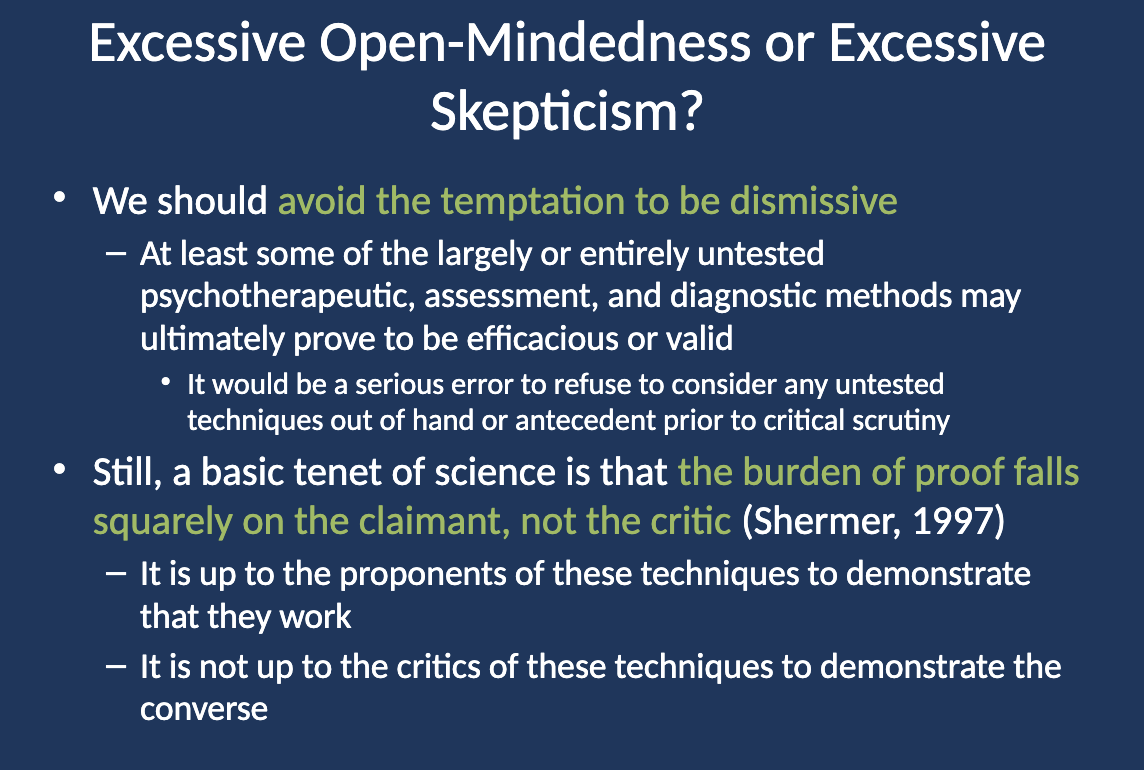
What is the basic tenet about the claimant and the critic in science? (Excessive Open-Mindedness or Excessive Skepticism?)
The burden of proof falls squarely on the claimant, not the critic.
It is the responsibility of the proponents of a technique to demonstrate its validity, not the critics to prove it doesn’t work.
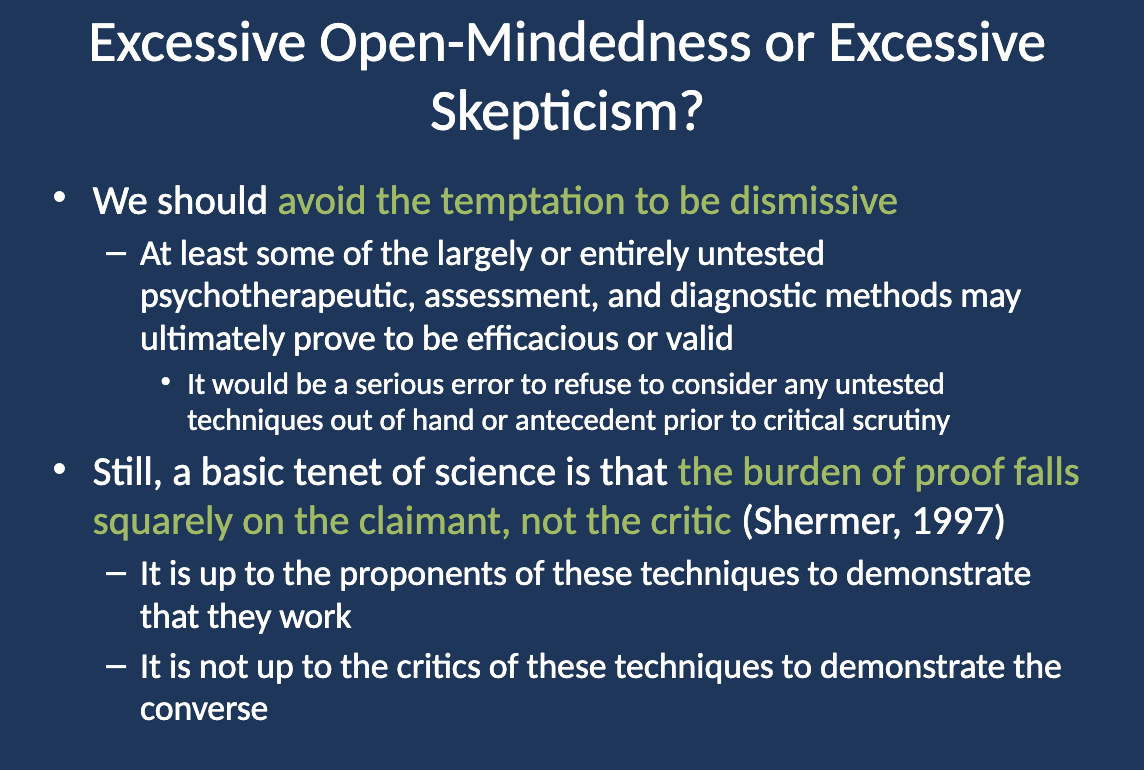
What did Carl Sagan say about scientific inquiry? (Excessive Open-Mindedness or Excessive Skepticism?)
Scientific inquiry requires a balance of open-mindedness and penetrating skepticism.
We must remain open to novel, untested claims, no matter how implausible they seem at first, while subjecting them to rigorous scientific scrutiny.

What must we do when encountering new and untested claims? (Excessive Open-Mindedness or Excessive Skepticism?)
We must remain open to considering them but also subject them to incisive scrutiny to ensure they withstand rigorous scientific testing.
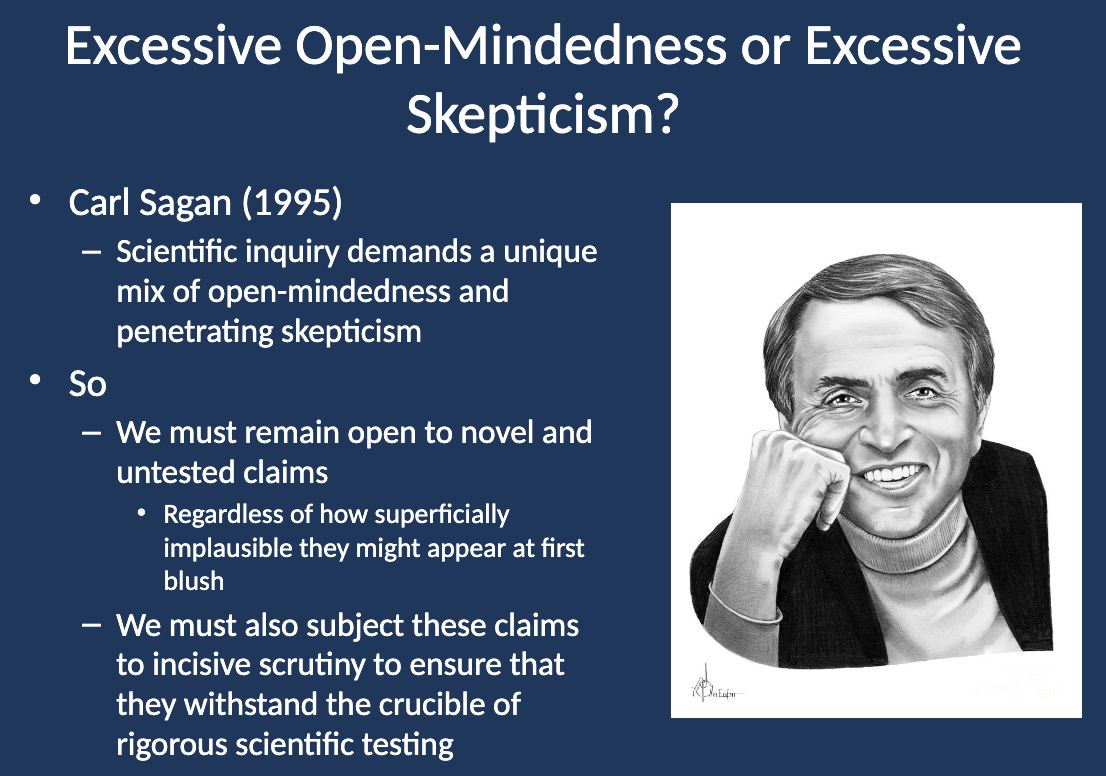
What did James Oberg say about keeping an open mind? (Excessive Open-Mindedness or Excessive Skepticism?)
Keeping an open mind is a virtue, but it cannot be so open that one’s brains fall out.
This principle is crucial in science, especially in applied areas like clinical psychology, where ineffective practices can lead to harm.
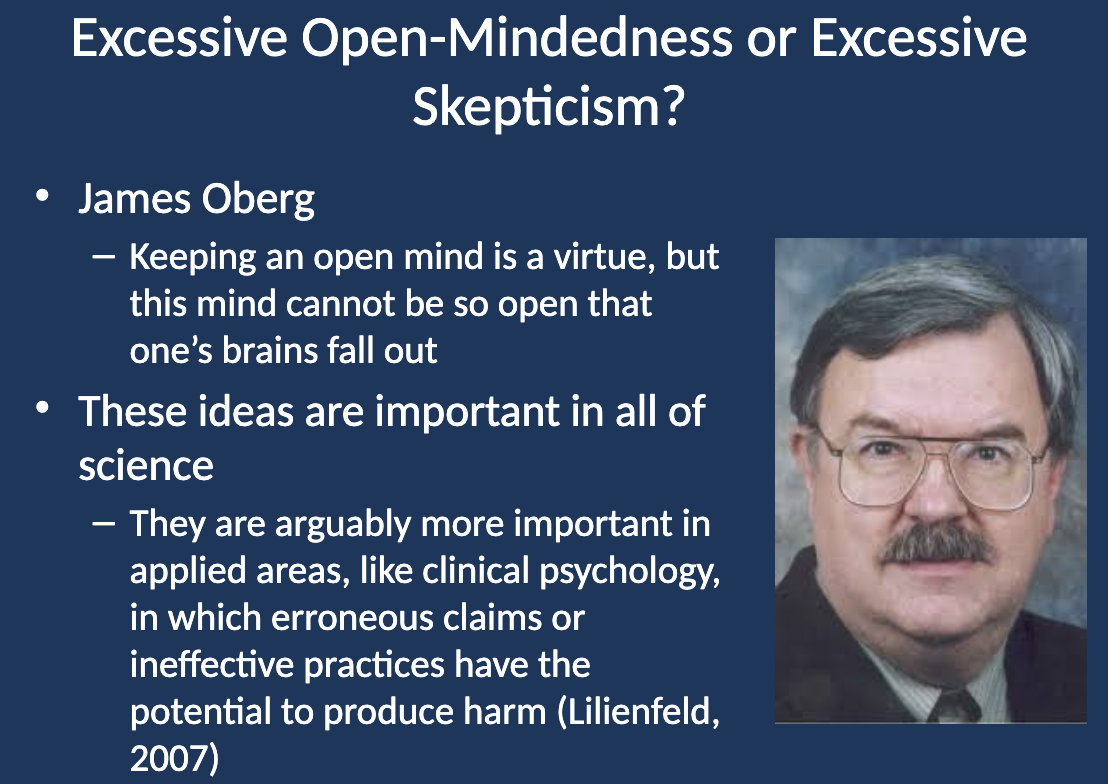
Why are the ideas of Carl Sagan and James Oberg important in science? (Excessive Open-Mindedness or Excessive Skepticism?)
These ideas are crucial in all of science, especially in applied fields like clinical psychology, where erroneous claims or ineffective practices can harm individuals.
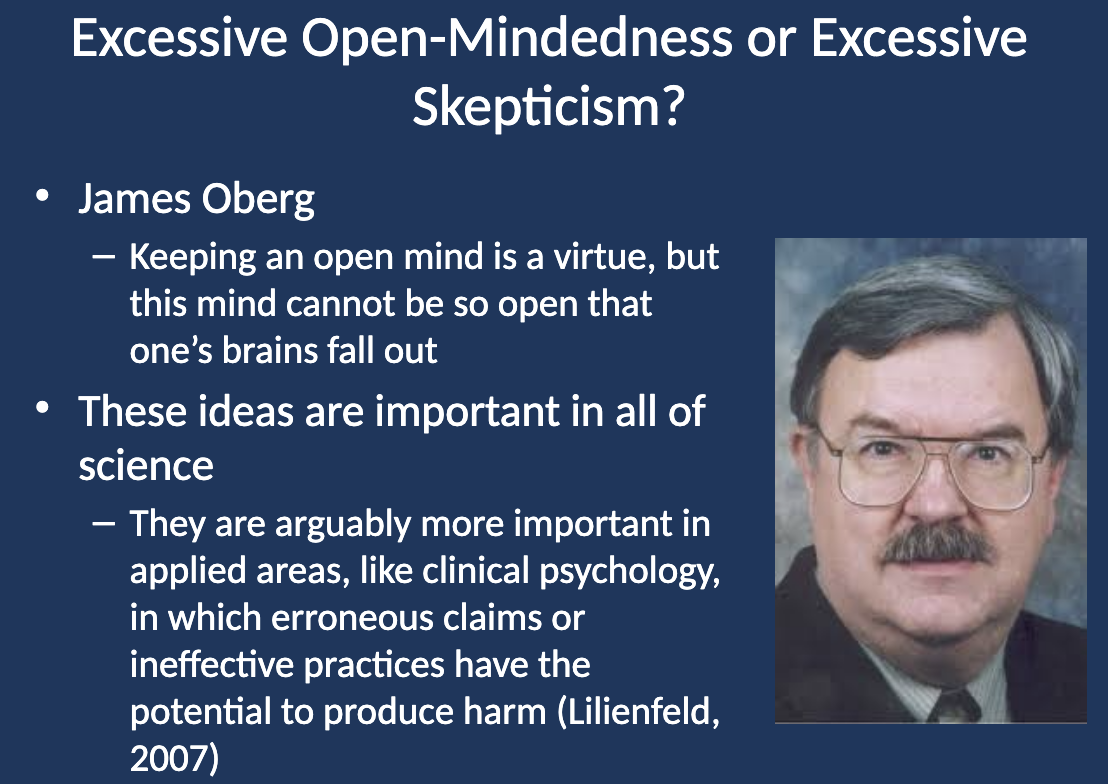
Why might some believe that potentially pseudoscientific techniques are harmless? (Why Potentially Pseudoscientific Techniques Can Be Harmful)
Some might argue that although many untested or ineffective techniques are being discussed, most are likely to prove either effective or harmless (innocuous).
This belief suggests that the dangers attributed to these techniques are overblown, as unresearched mental health practices may be inert at worst.
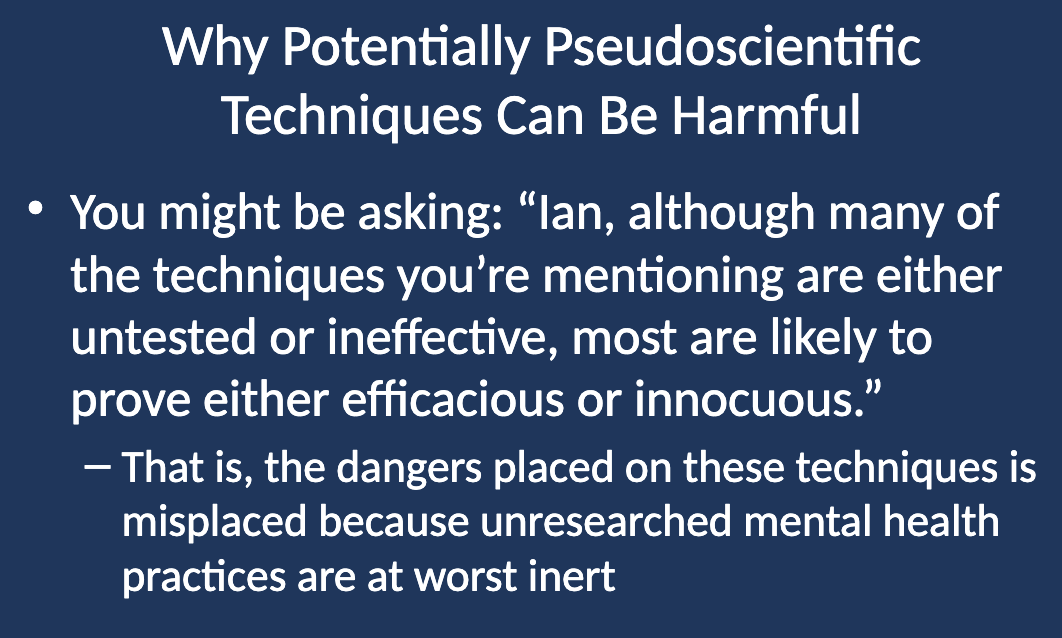
Where can you find examples of the potential harm caused by pseudoscientific techniques? (Why Potentially Pseudoscientific Techniques Can Be Harmful)
A resource like What’s The Harm provides examples of how untested or pseudoscientific practices can have harmful effects.

What are the three major ways in which unsubstantiated mental health techniques can be harmful? (Why Potentially Pseudoscientific Techniques Can Be Harmful)
Some of these techniques may be harmful.
Psychotherapies by themselves may have unintended consequences.
The use of unsubstantiated techniques erodes the scientific foundation of clinical psychology.

What is the first major way unsubstantiated techniques can be harmful? (Why Potentially Pseudoscientific Techniques Can Be Harmful)
Some techniques may directly cause harm, such as in the case of rebirthing therapy, which led to the tragic death of 10-year-old Candace Newmaker in 2000.
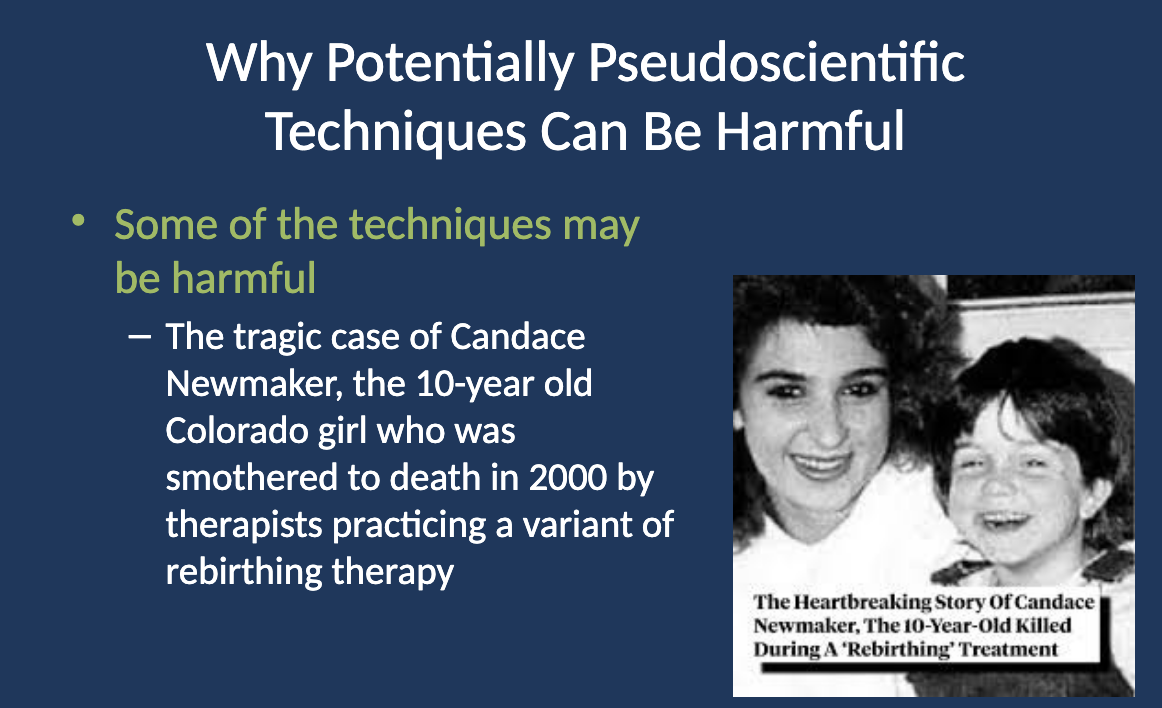
What are some techniques that can be harmful? (Why Potentially Pseudoscientific Techniques Can Be Harmful)
Suggestive techniques: (e.g., hypnosis, guided imagery)
Facilitated communication for autism
Accumulating evidence suggests that other widely used treatments (e.g., critical incident stress debriefing, Scared Straight programs, certain self-help programs) can also be harmful.
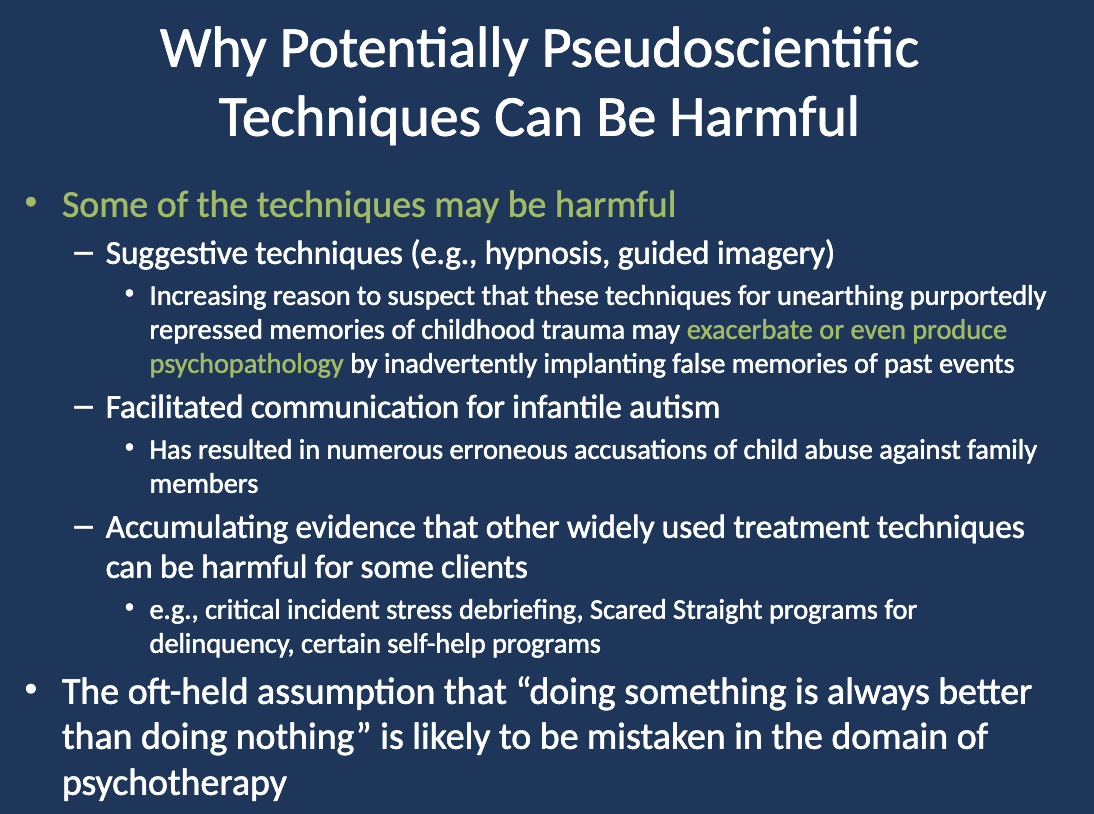
What are suggestive techniques, and how can they be harmful? (Why Potentially Pseudoscientific Techniques Can Be Harmful)
Techniques like hypnosis and guided imagery, which are used to "unearth" repressed memories of trauma.
They may inadvertently implant false memories and exacerbate or create psychopathology.

What is facilitated communication for autism, and how can it be harmful? (Why Potentially Pseudoscientific Techniques Can Be Harmful)
Facilitated communication is a method for helping individuals with autism communicate.
It has led to erroneous accusations of child abuse against family members, as it can falsely suggest the child’s messages are their own.

What does "accumulating evidence" suggest about certain widely used treatments? (Why Potentially Pseudoscientific Techniques Can Be Harmful)
Some treatments, like critical incident stress debriefing, Scared Straight programs, and some self-help programs, have been shown to be harmful for certain clients.

Why is the assumption that “doing something is always better than doing nothing” mistaken in psychotherapy? (Why Potentially Pseudoscientific Techniques Can Be Harmful)
This assumption may not hold true, as doing the wrong thing (using ineffective or harmful techniques) can be worse than doing nothing at all.
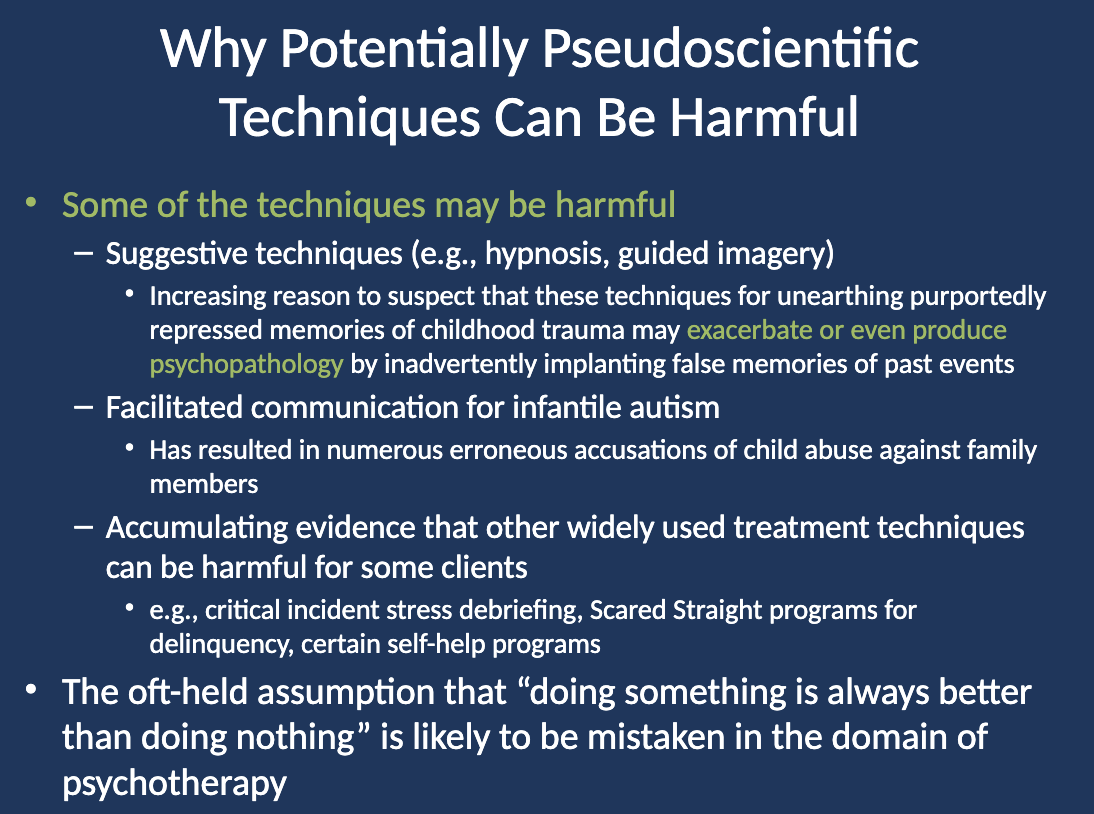
What is the second major way unsubstantiated techniques can be harmful? (Why Potentially Pseudoscientific Techniques Can Be Harmful)
Even psychotherapies that are harmless by themselves can still cause harm by using up valuable resources like time and money.
This is referred to as "opportunity cost" in economics.
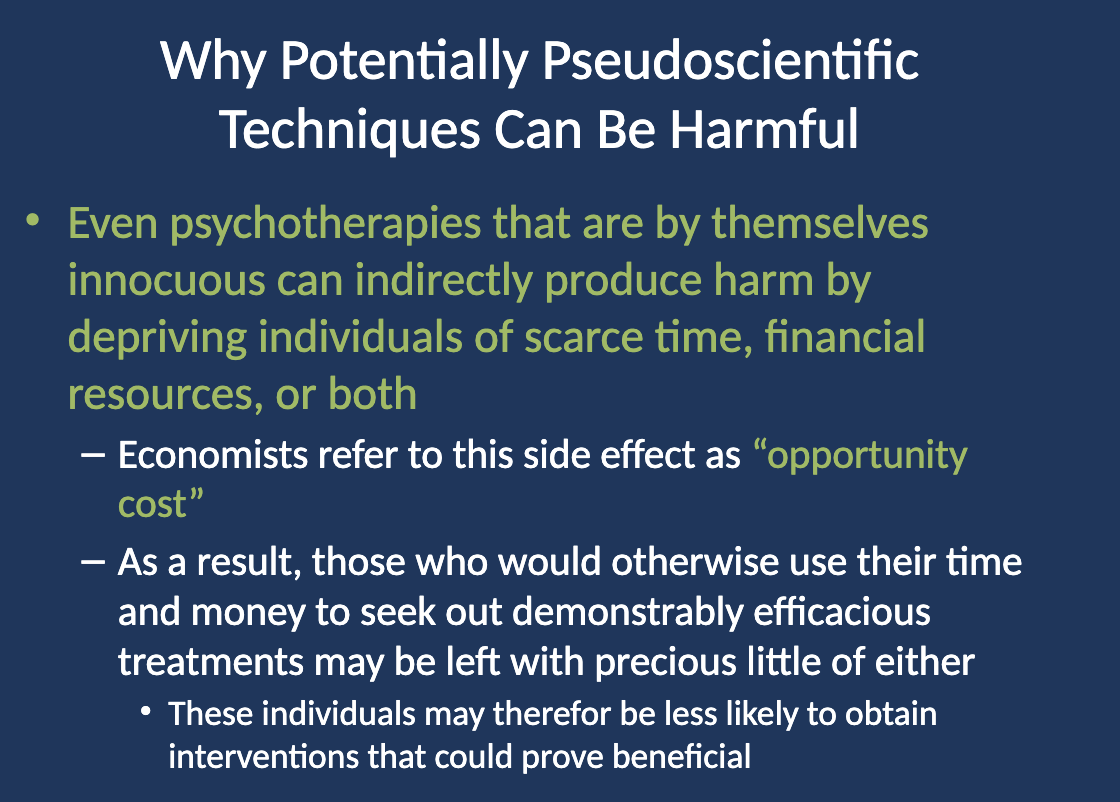
What is opportunity cost, and how does it apply to psychotherapy? (Why Potentially Pseudoscientific Techniques Can Be Harmful)
Opportunity cost refers to the value of the opportunities lost when choosing one option over another.
In psychotherapy, spending time and money on unproven treatments may prevent individuals from accessing more effective therapies.
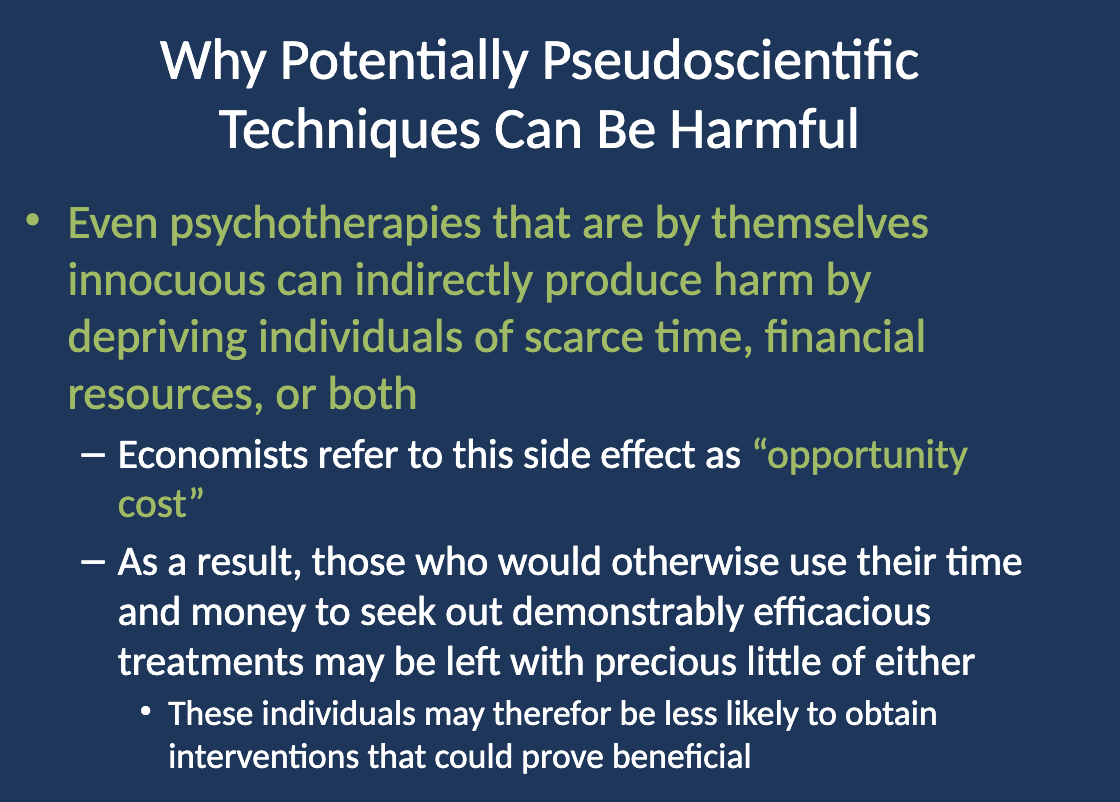
What is the third major way unsubstantiated techniques can be harmful? (Why Potentially Pseudoscientific Techniques Can Be Harmful)
The use of unsubstantiated techniques erodes the scientific foundation of clinical psychology by undermining the profession’s credibility and damaging its commitment to scientific evidence.
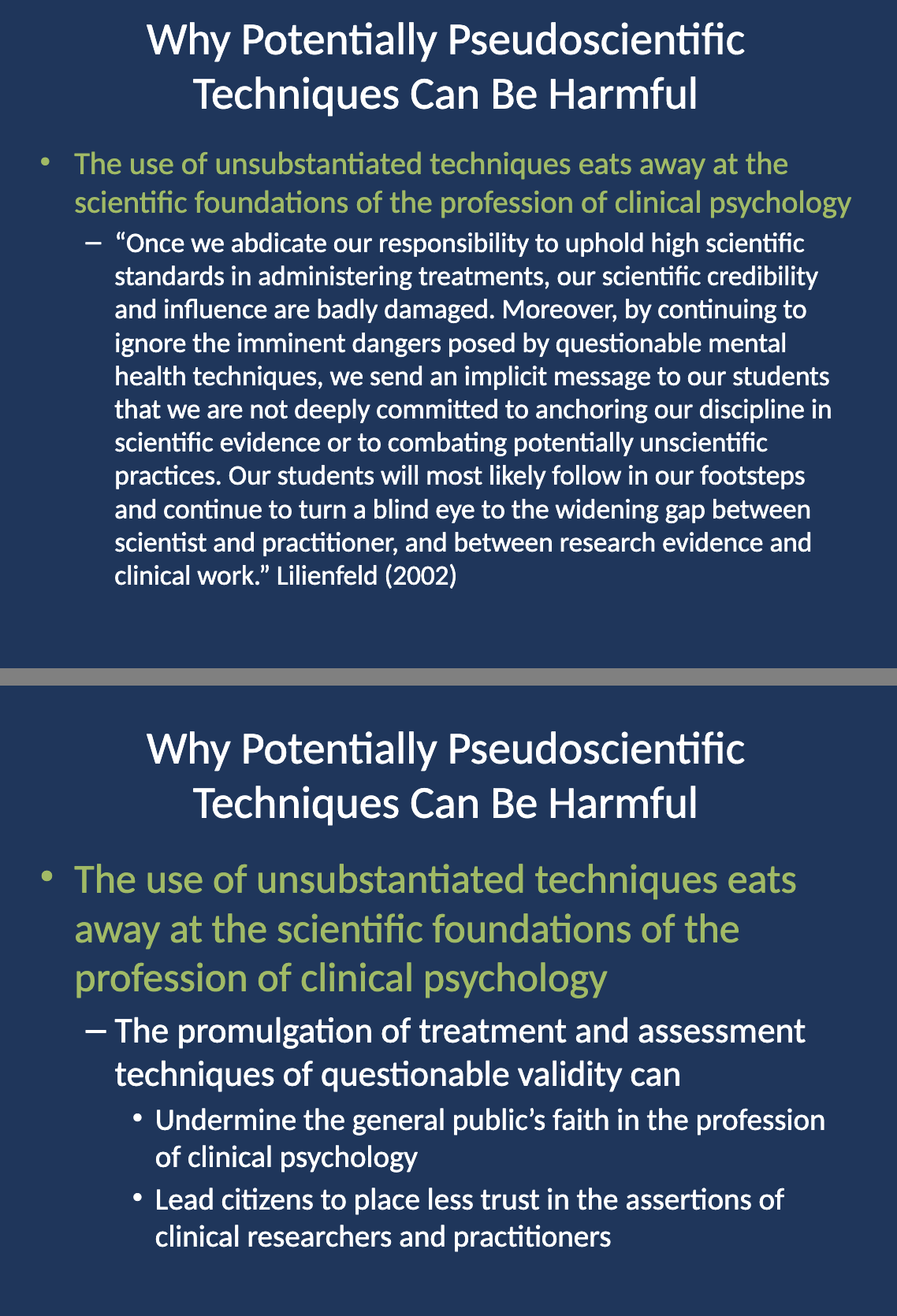
How can the promulgation of unsubstantiated techniques harm clinical psychology? (Why Potentially Pseudoscientific Techniques Can Be Harmful)
It can undermine the public’s trust in the profession.
It can lead to people placing less trust in clinical researchers and practitioners, diminishing the scientific foundation of the field.
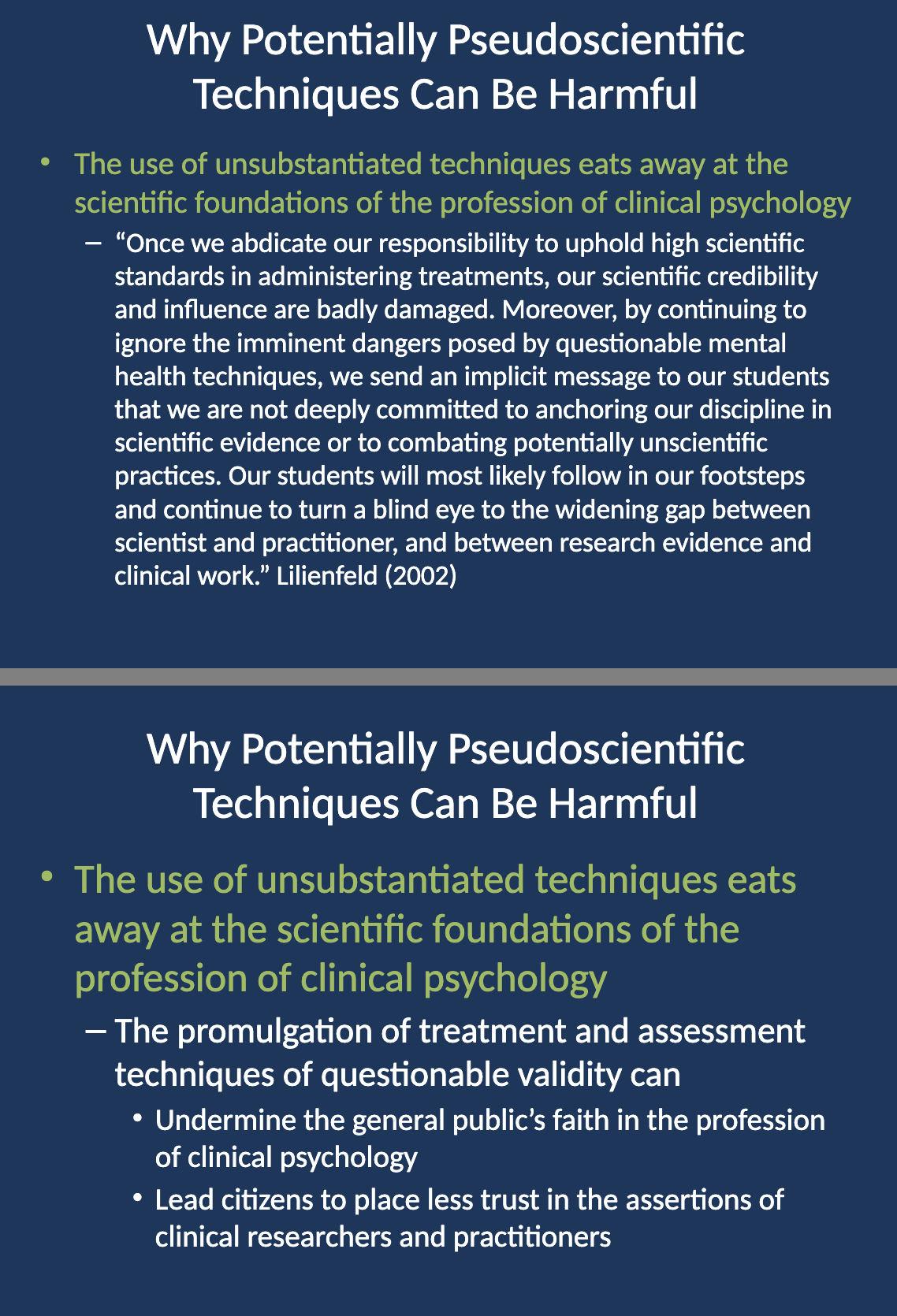
What is the general distinction between science and pseudoscience? (The Difference Between Science and Pseudoscience)
Science and pseudoscience differ in degree, not kind; they exist on a continuum with fuzzy boundaries, and pseudoscience exhibits multiple warning signs that signal a drift from scientific standards.
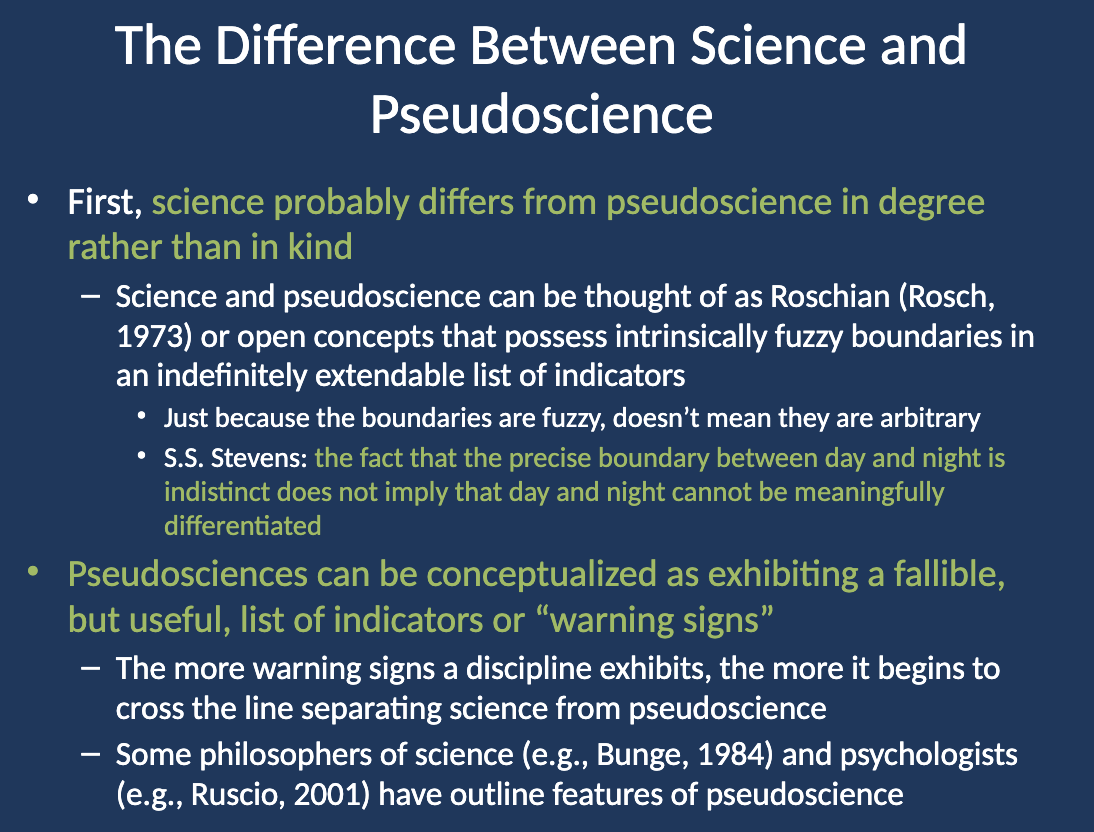
What did S.S. Stevens say about fuzzy boundaries between concepts? (The Difference Between Science and Pseudoscience)
Stevens noted that just because the boundary between day and night is indistinct, that doesn't mean we can't meaningfully distinguish them—similarly, science and pseudoscience can still be differentiated despite fuzzy boundaries.
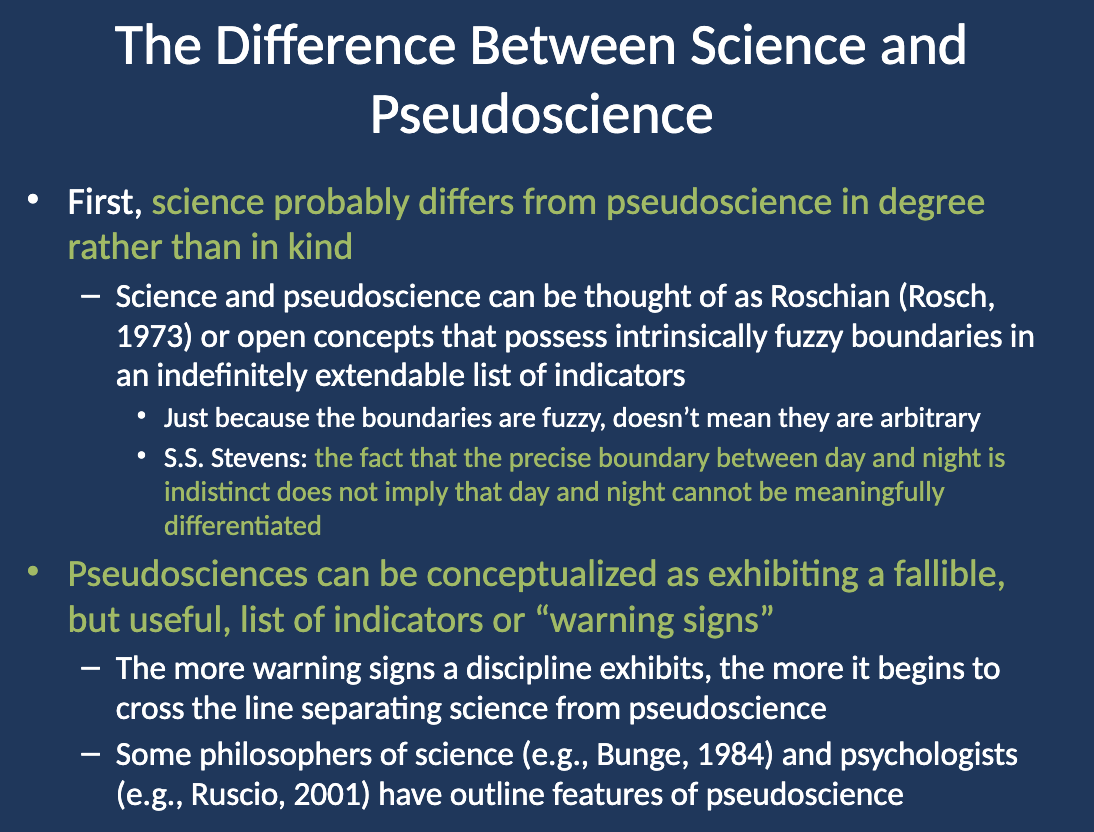
How can pseudoscience be conceptualized? (The Difference Between Science and Pseudoscience)
Pseudoscience can be understood as exhibiting a fallible but useful set of warning signs; the more signs a discipline shows, the more it crosses the line from science to pseudoscience. These are not definitive rules, but helpful indicators.
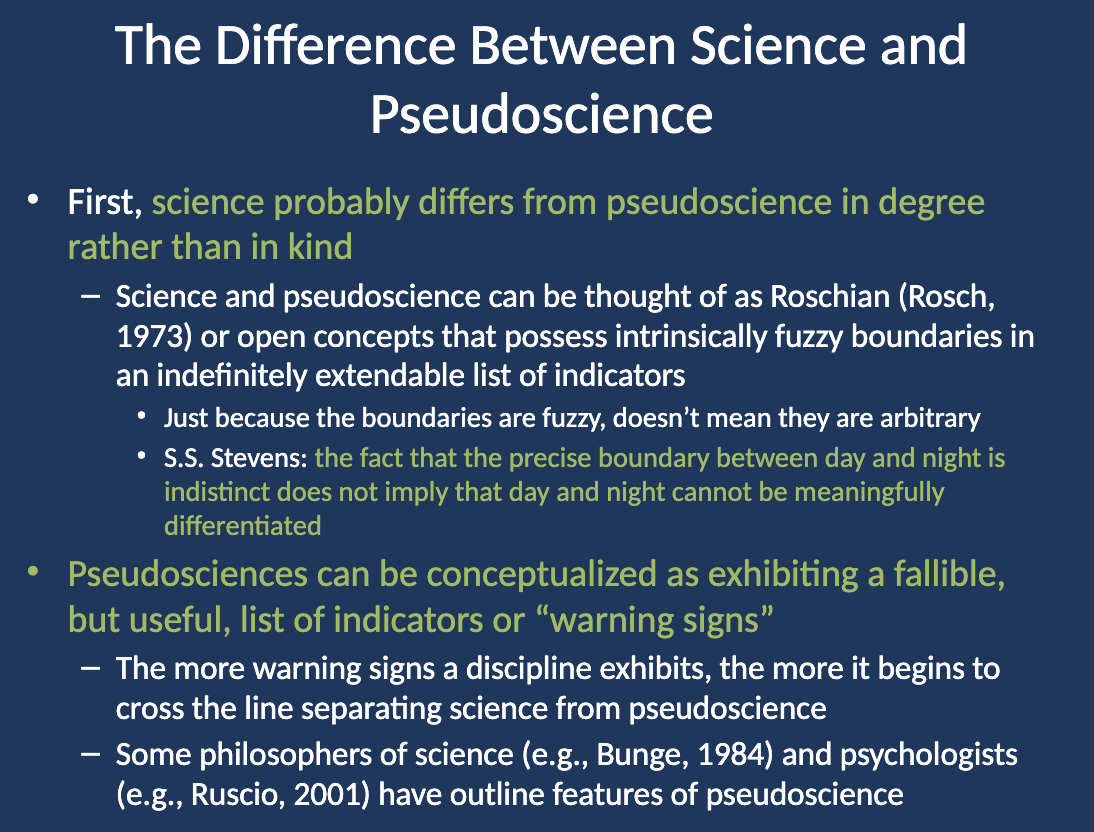
What is the 1st major difference between science and pseudoscience? (The Difference Between Science and Pseudoscience)
Overuse of ad hoc hypotheses to shield claims from falsification—pseudoscientists add unfalsifiable excuses to explain away negative results, which prevents theories from being tested and refuted.
What does the first major difference (overuse of ad hoc hypotheses) mean? (The Difference Between Science and Pseudoscience)
The overuse of ad hoc hypotheses means adding explanations to protect a claim from being disproven, rather than making the claim testable. This practice is common in pseudoscience and prevents falsification by continuously modifying the theory to accommodate any negative findings.
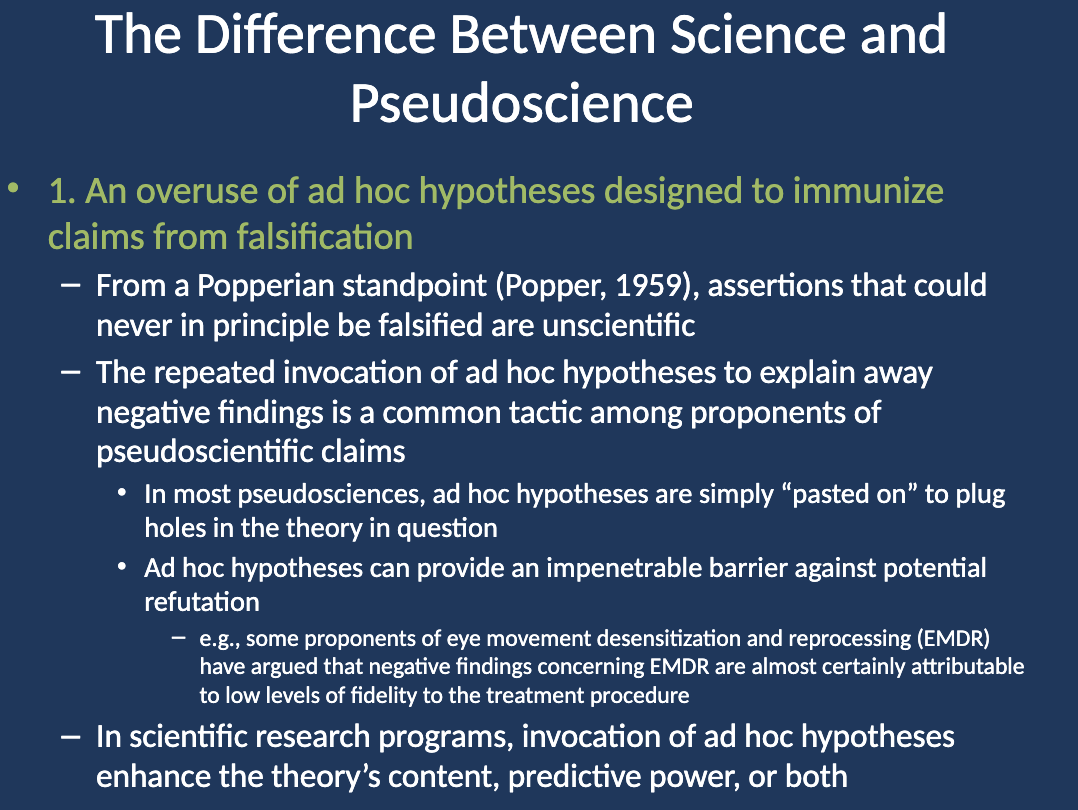
What is the Popperian standpoint on falsification? (The Difference Between Science and Pseudoscience)
According to Popper (1959), claims that cannot in principle be falsified (i.e., proven wrong) are unscientific. Scientific theories must be testable and open to refutation through evidence.
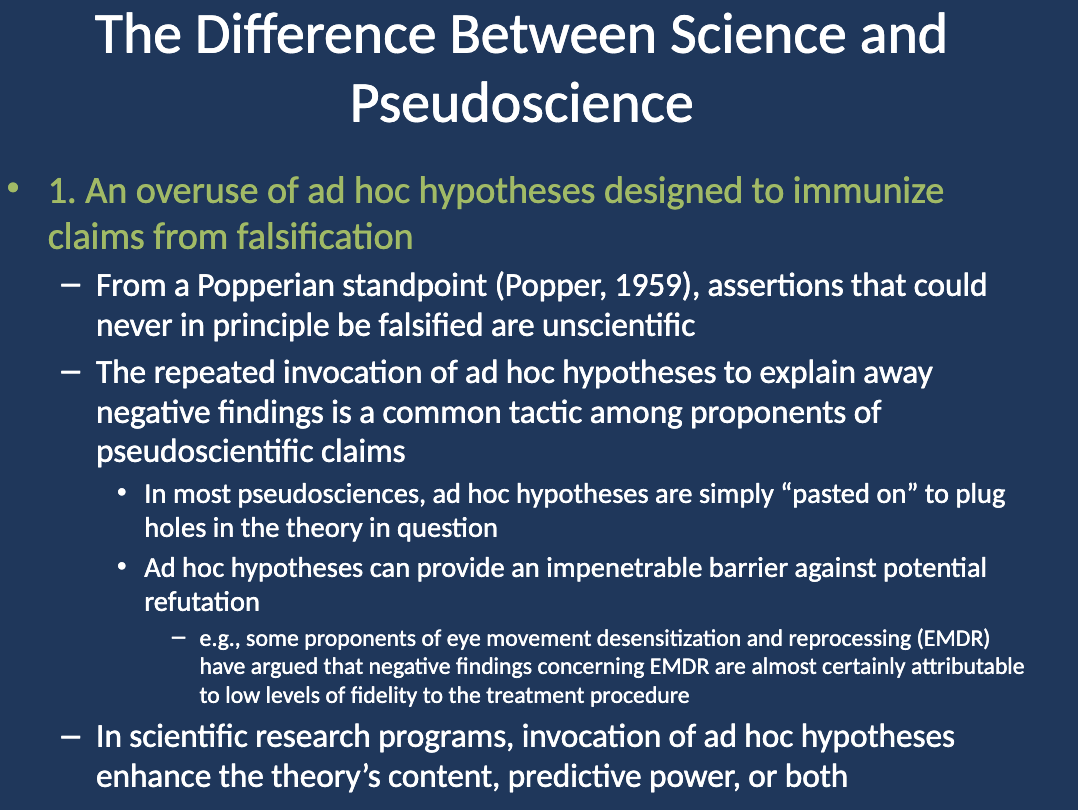
What is a common tactic used in pseudoscience, and how does it work? (The Difference Between Science and Pseudoscience)
A common tactic in pseudoscience is the use of ad hoc hypotheses to explain away negative findings. These hypotheses are often added to patch up weaknesses in a theory, making it nearly impossible to disprove the claim. For example, proponents of EMDR suggest that negative findings are due to low levels of fidelity in following the treatment procedure.
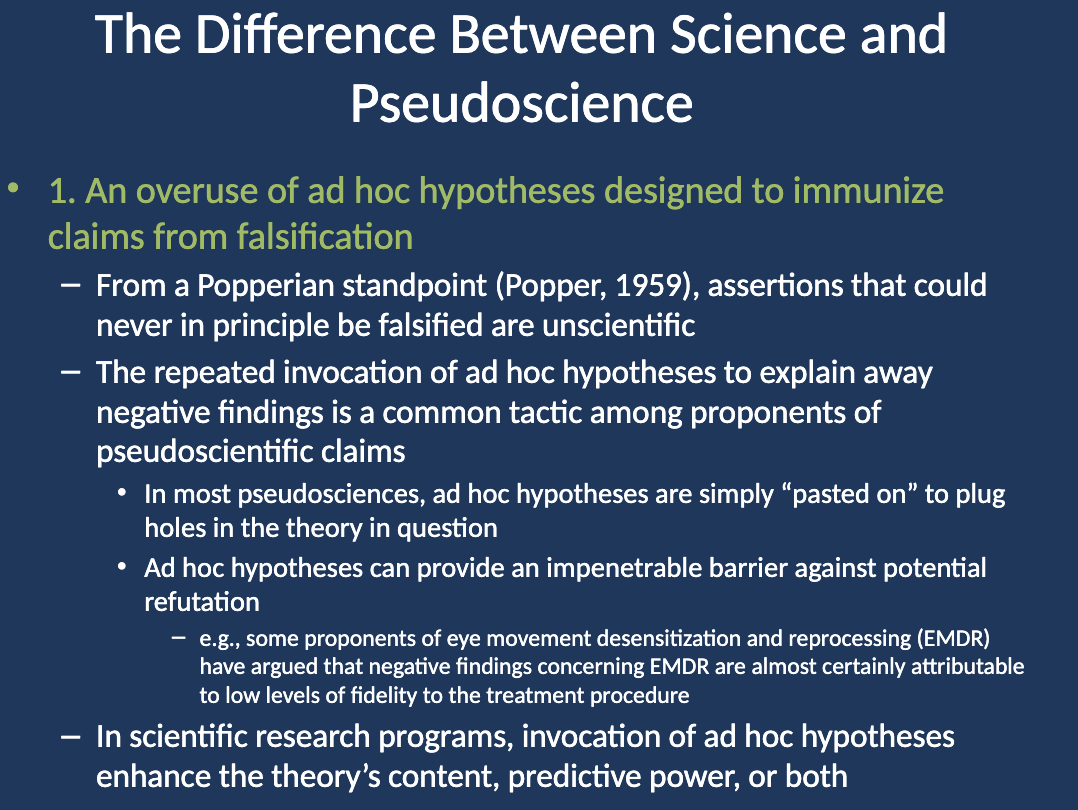
How do scientific research programs handle ad hoc hypotheses? (The Difference Between Science and Pseudoscience)
In scientific programs, the use of ad hoc hypotheses isn't to protect the theory but to enhance its content and predictive power. These hypotheses serve to refine the theory and contribute to its growth rather than making it impenetrable to refutation.
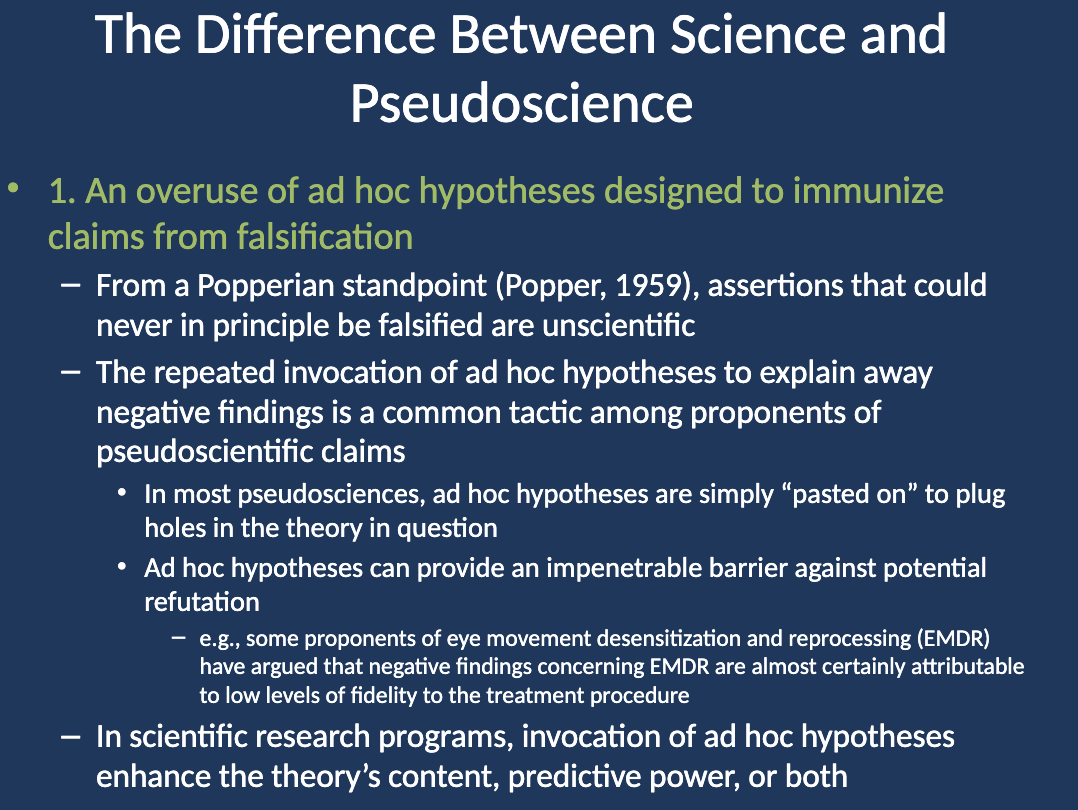
What is the 2nd major difference between science and pseudoscience? (The Difference Between Science and Pseudoscience)
Absence of self-correction—scientific fields eliminate errors over time, while pseudoscientific programs tend to remain stagnant and unchanged (e.g., astrology has barely changed in 2,500 years).
What is the second major difference between science and pseudoscience? (2) (The Difference Between Science and Pseudoscience)
The second major difference is the absence of self-correction in pseudoscientific programs. In science, incorrect assumptions are typically identified and corrected over time, whereas pseudoscientific programs tend to persist with errors, leading to stagnation.

How do scientific programs differ from pseudoscientific programs regarding self-correction? (The Difference Between Science and Pseudoscience)
Scientific programs are dynamic and self-correcting. They continuously refine and improve based on new evidence and eliminate errors. In contrast, pseudoscientific programs often do not correct their mistakes, maintaining flawed assumptions over time.
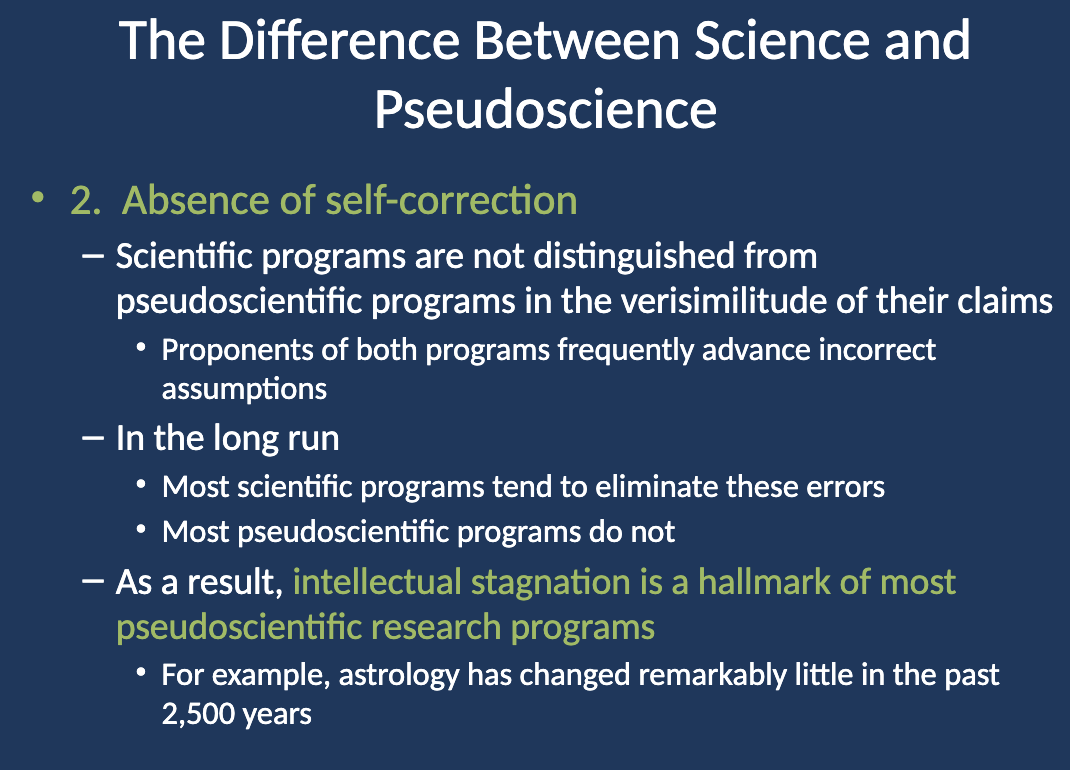
What happens in the long run for scientific vs pseudoscientific programs? (The Difference Between Science and Pseudoscience)
In the long run, scientific programs eliminate errors, correct misconceptions, and evolve with new evidence. Pseudoscientific programs, however, tend to ignore or deny errors, preventing meaningful progress and growth.
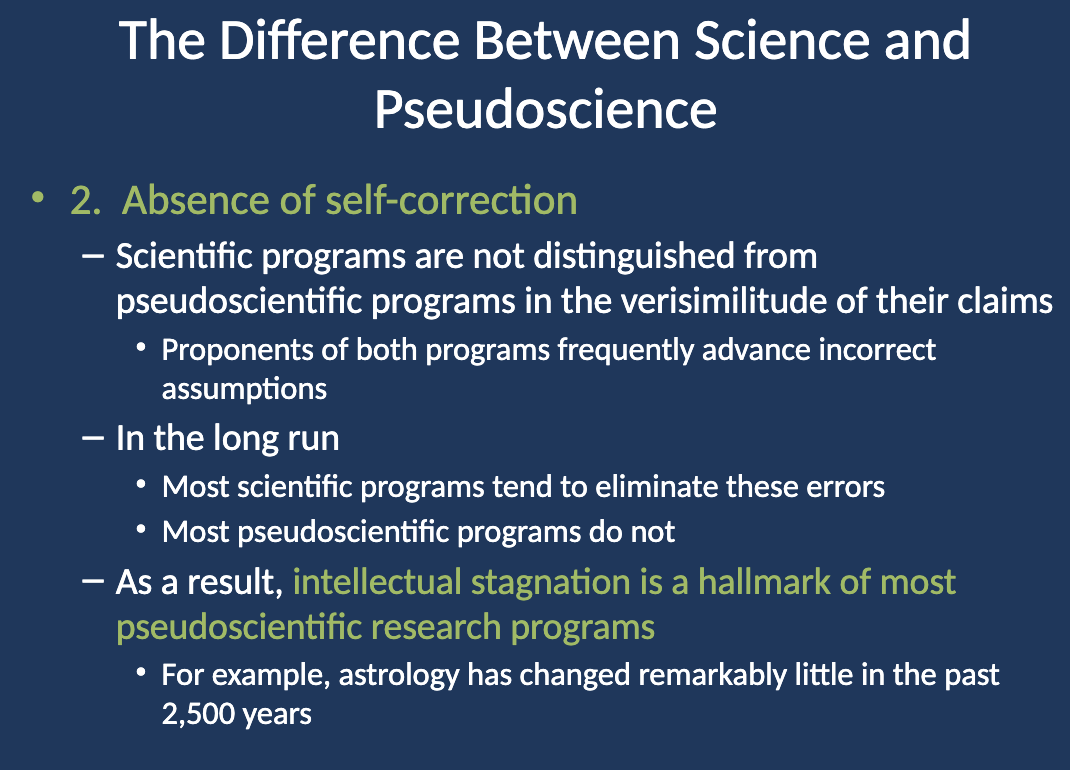
What is the result of the lack of self-correction in pseudoscientific programs? (The Difference Between Science and Pseudoscience)
As a result of the lack of self-correction, pseudoscientific programs experience intellectual stagnation. They do not evolve or improve over time, often clinging to outdated or incorrect theories. For example, astrology has remained largely unchanged for the past 2,500 years.
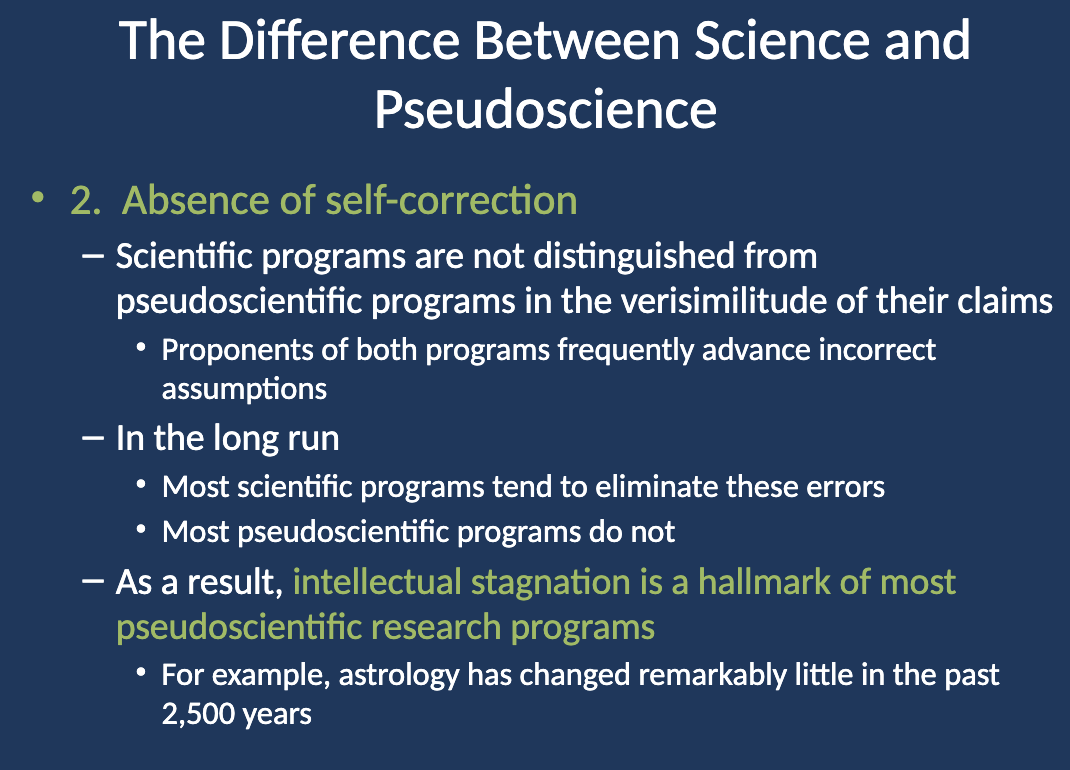
What is the 3rd major difference between science and pseudoscience? (The Difference Between Science and Pseudoscience)
Evasion of peer review—pseudoscientists often avoid peer review, claiming bias or incompatibility with standard methods, which isolates them from corrective feedback and critical scrutiny.
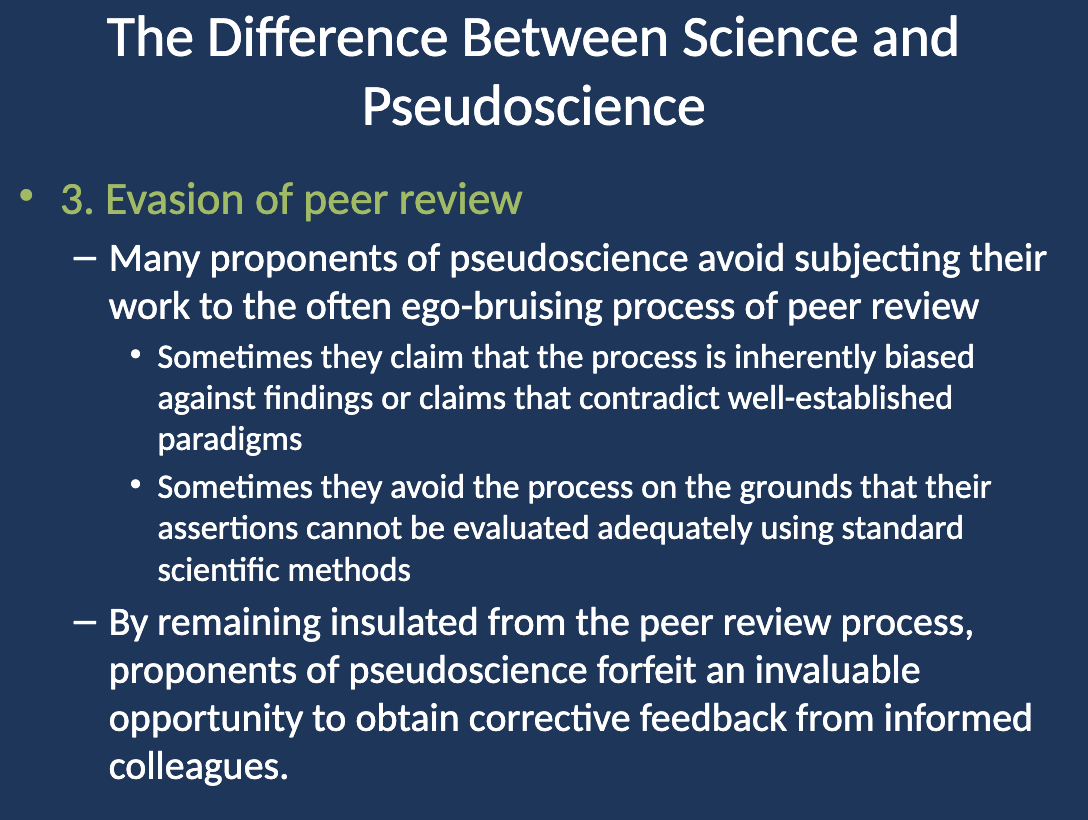
What does evasion of peer review mean in pseudoscience? (The Difference Between Science and Pseudoscience)
Evasion of peer review refers to the practice of avoiding the peer review process—a standard procedure in science where other experts evaluate research. Proponents of pseudoscience often refuse to submit their work for this process, which is seen as essential for ensuring scientific rigor and credibility.

How do proponents of pseudoscience avoid subjecting their work to peer review? (The Difference Between Science and Pseudoscience)
Proponents of pseudoscience often avoid peer review by claiming that the process is biased against new ideas that contradict well-established paradigms, or they argue that their claims cannot be evaluated adequately using standard scientific methods.

What do proponents of pseudoscience forfeit by avoiding peer review? (The Difference Between Science and Pseudoscience)
By avoiding peer review, proponents of pseudoscience forfeit an invaluable opportunity to receive corrective feedback from informed colleagues, which could help identify errors, improve their work, and ensure the validity of their claims.

What is the 4th major difference between science and pseudoscience? (The Difference Between Science and Pseudoscience)
Emphasis on confirmation rather than refutation—science seeks to disprove claims to refine knowledge, while pseudoscience focuses only on confirmatory evidence and ignores contradictory data.
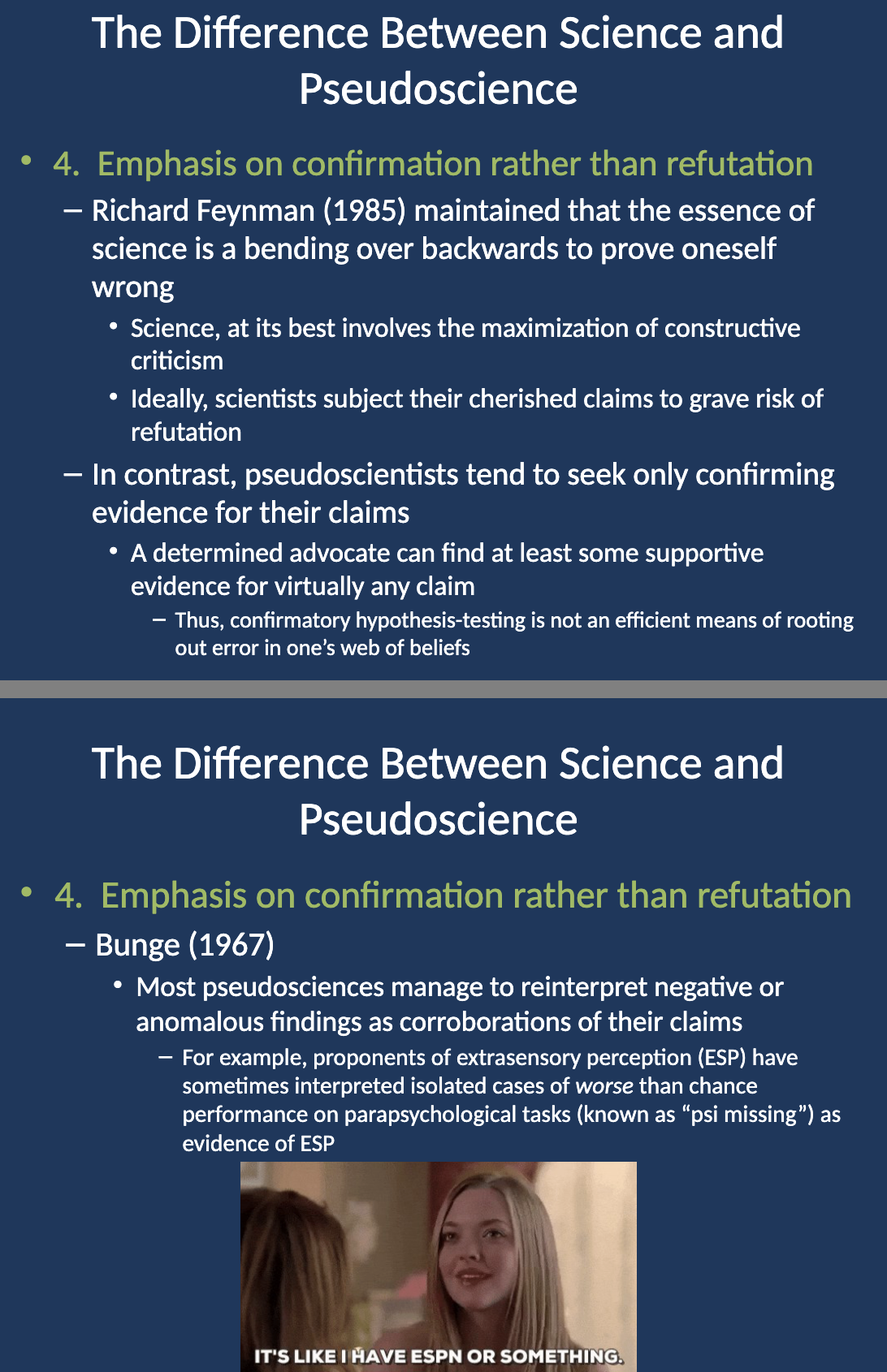
What is an example of pseudoscientific confirmation bias? (The Difference Between Science and Pseudoscience)
In ESP research, "psi missing" (performing worse than chance) is reinterpreted as evidence for ESP, rather than against it.
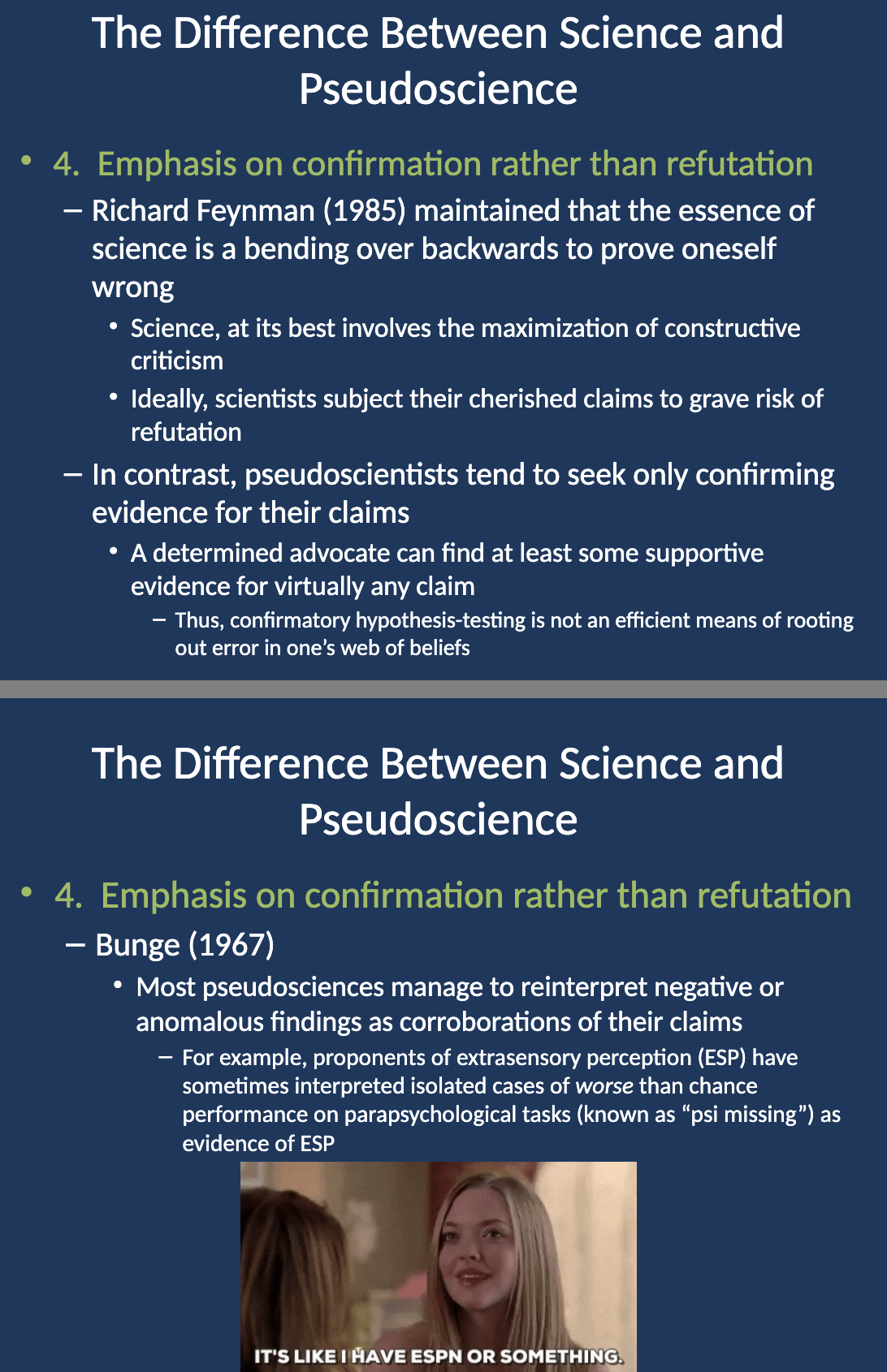
What does emphasis on confirmation mean in the context of pseudoscience? (The Difference Between Science and Pseudoscience)
Emphasis on confirmation refers to the tendency of pseudoscientists to seek only evidence that supports their claims, rather than subjecting their theories to potential refutation or challenging their assumptions. This contrasts with scientific inquiry, which values the process of testing and falsifying hypotheses.

What did Richard Feynman say about the essence of science? (The Difference Between Science and Pseudoscience)
Richard Feynman (1985) stated that the essence of science is a "bending over backwards to prove oneself wrong." This means scientists must be willing to subject their ideas to rigorous scrutiny and constructive criticism in order to disprove their own claims and ensure the accuracy of their work.
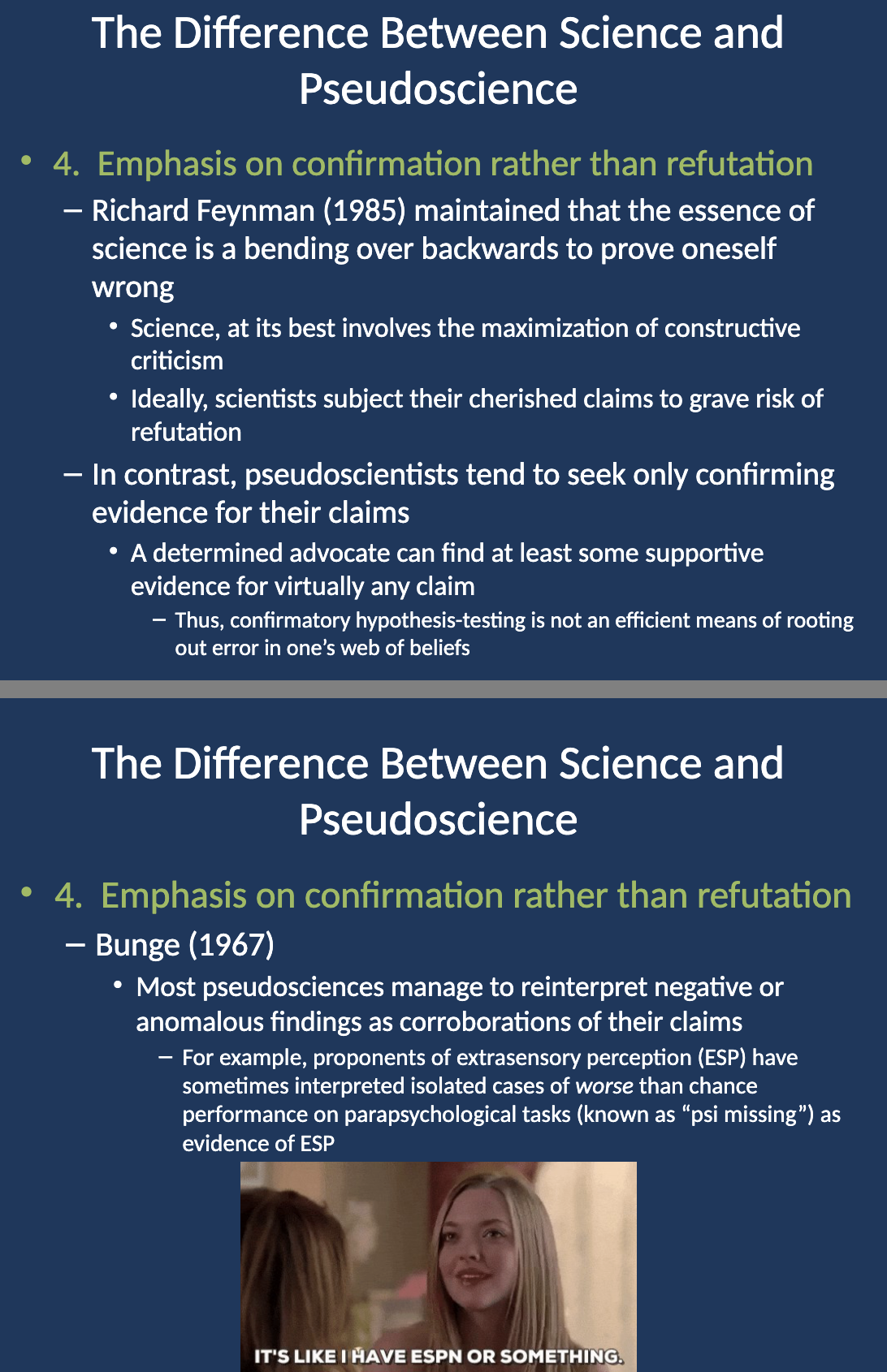
How do pseudoscientists contrast with Feynman's view of science? (The Difference Between Science and Pseudoscience)
Pseudoscientists contrast with Feynman's view by seeking only confirming evidence for their claims. They tend to avoid subjecting their ideas to challenges or attempts to disprove them, which limits their ability to identify errors or improve their theories.

What did Bunge (1967) say about pseudoscientific practices? (The Difference Between Science and Pseudoscience)
Bunge (1967) explained that pseudosciences often reinterpret negative or anomalous findings as evidence that supports their claims, rather than accepting the findings as refutations. This tactic allows them to avoid confronting weaknesses in their theories.

Can you give an example of Bunge's idea about how pseudosciences reinterpret findings? (The Difference Between Science and Pseudoscience)
An example of Bunge's idea is found in extrasensory perception (ESP) proponents. When experiments show worse-than-chance performance (known as “psi missing”), some ESP advocates reinterpret these negative findings as evidence of ESP, rather than acknowledging them as failures of the theory.

What is the 5th major difference between science and pseudoscience? (The Difference Between Science and Pseudoscience)
Reversed burden of proof—in science, the claimant must prove the claim, but pseudoscience shifts the burden to skeptics, committing the argument from ignorance fallacy (e.g., UFO proponents demanding skeptics explain every case).
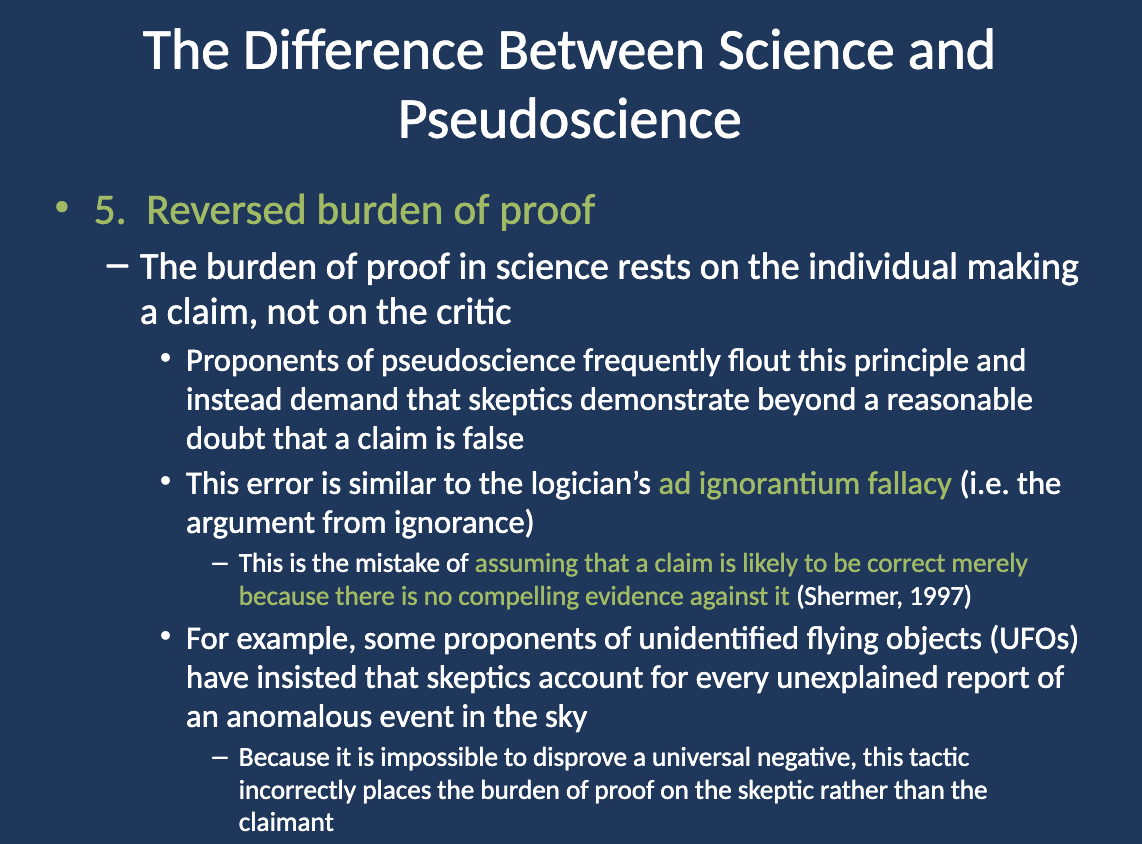
What does reversed burden of proof mean in pseudoscience? (The Difference Between Science and Pseudoscience)
Reversed burden of proof refers to the tactic used by proponents of pseudoscience where they demand that skeptics prove their claims wrong, instead of providing evidence to support their own claims. In science, the burden of proof lies on the individual making the claim.
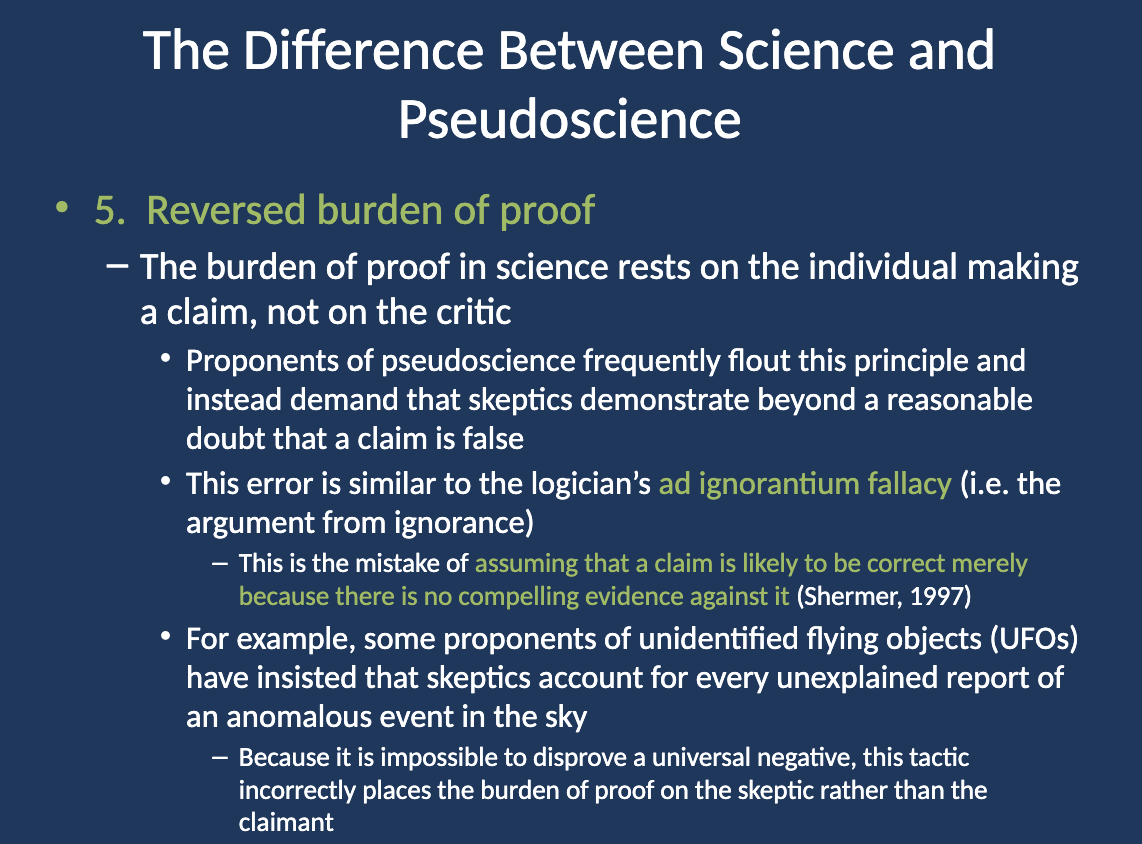
In science, where does the burden of proof rest, and why? (The Difference Between Science and Pseudoscience)
In science, the burden of proof rests on the individual making the claim. This is because they must provide compelling evidence to support their assertions. Without this evidence, the claim remains unproven, and the default position is skepticism.
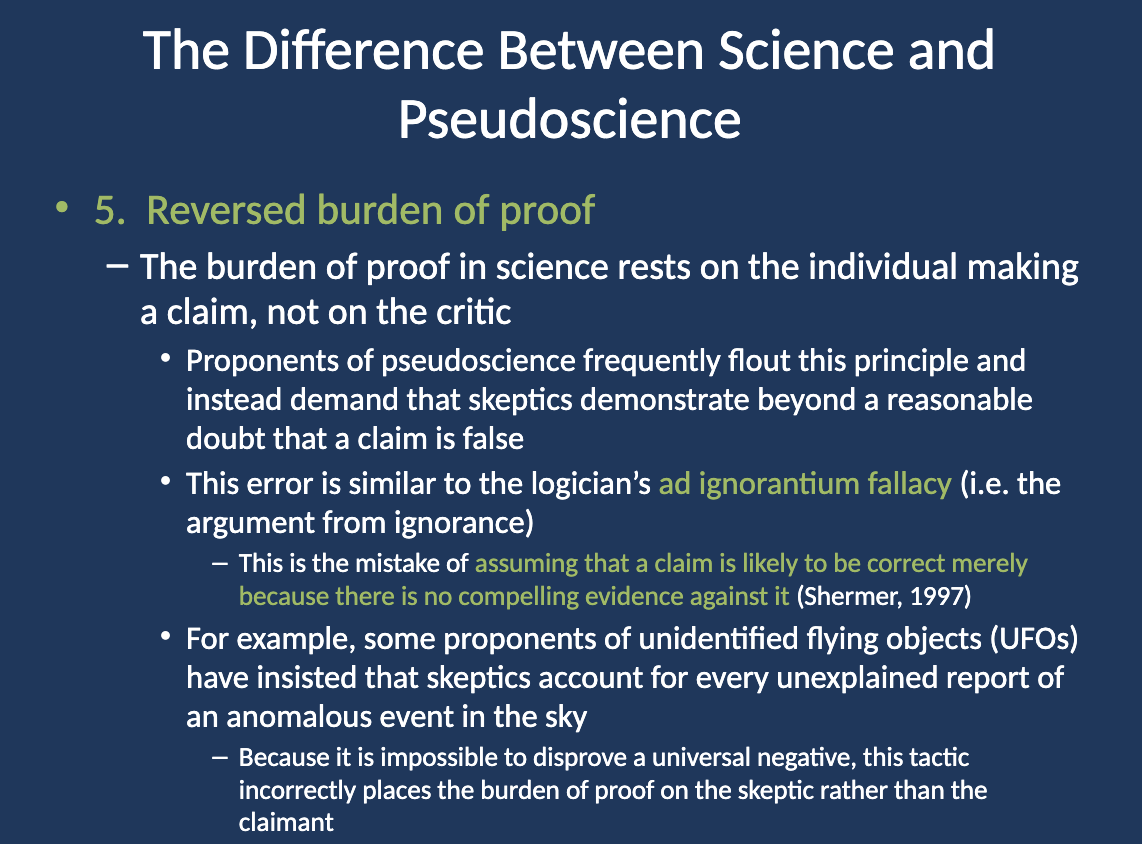
What error is reversed burden of proof similar to? (The Difference Between Science and Pseudoscience)
The reversed burden of proof error is similar to the ad ignorantium fallacy, also known as the argument from ignorance. This fallacy assumes that a claim is likely to be true simply because there is no compelling evidence against it.
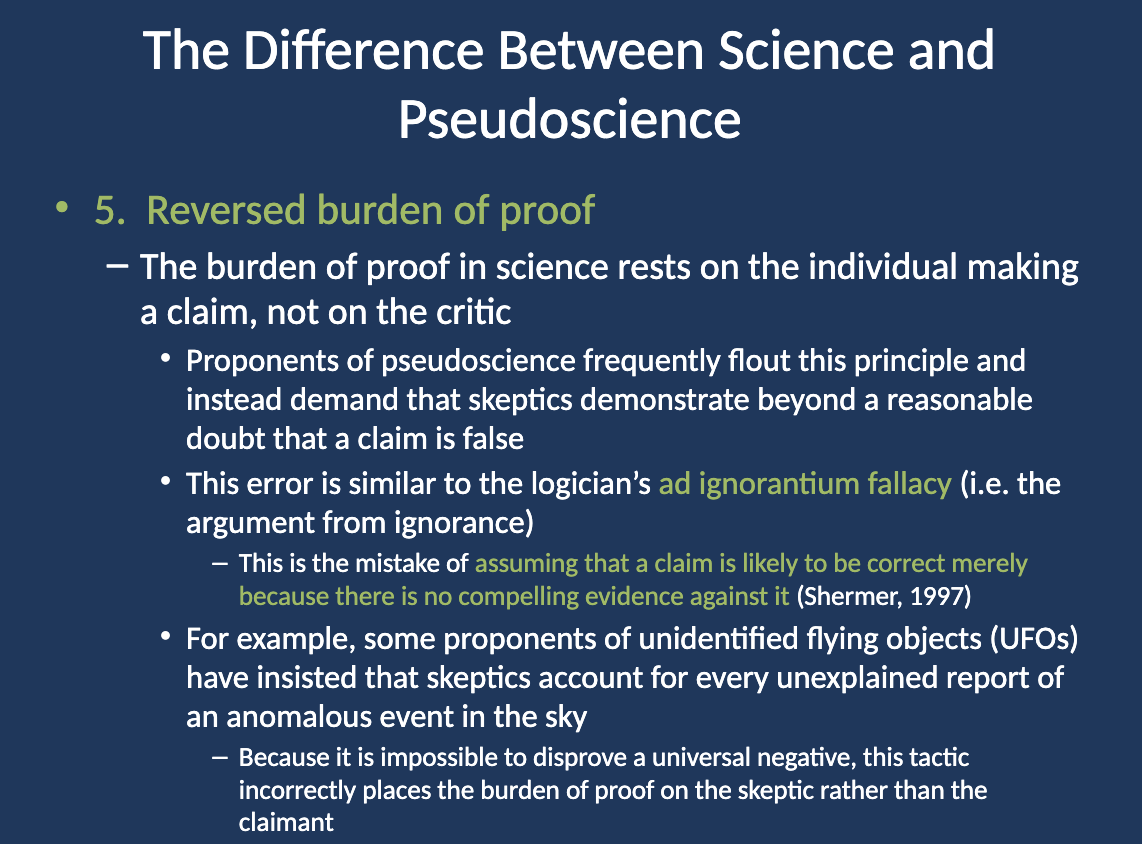
What is the ad ignorantium fallacy? (The Difference Between Science and Pseudoscience)
The ad ignorantium fallacy is a logical mistake where someone argues that a claim is true because it has not been proven false. It assumes that lack of disproof equals proof of truth, which is an incorrect reasoning process.
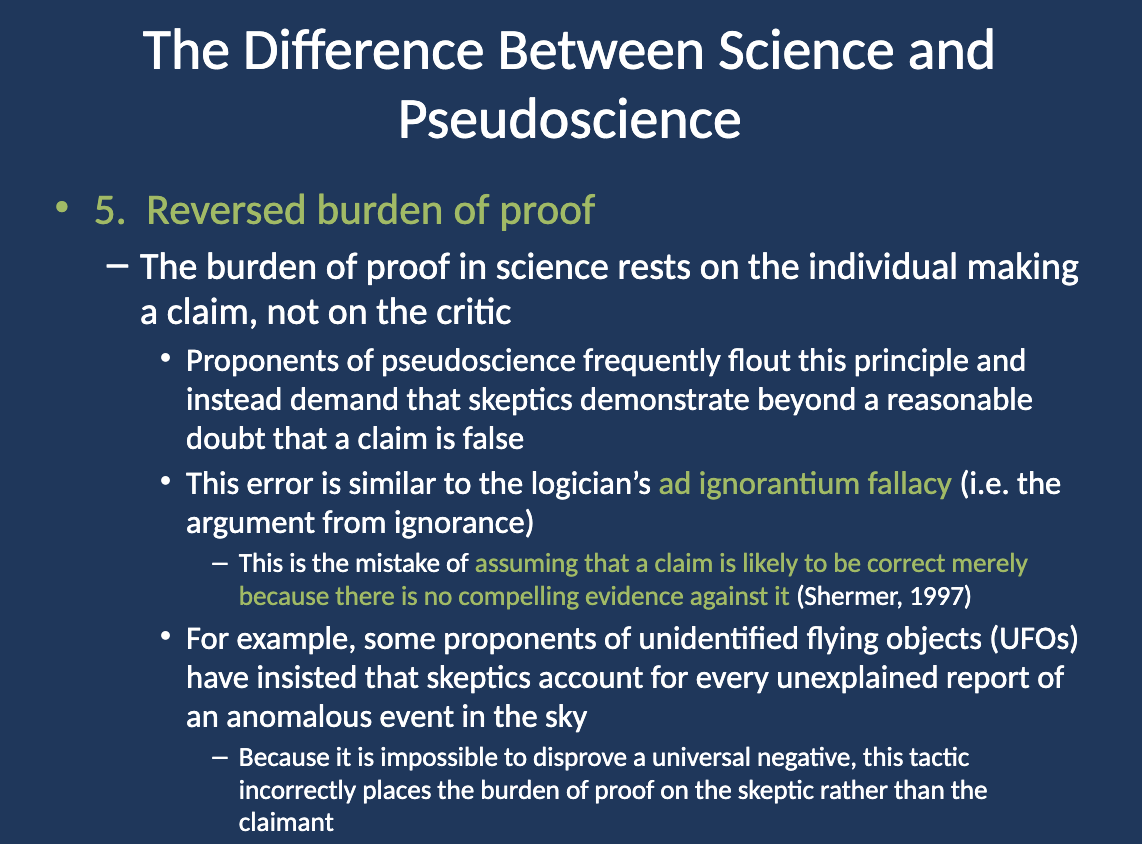
Can you provide an example of the reversed burden of proof? (The Difference Between Science and Pseudoscience)
A common example is seen in discussions about unidentified flying objects (UFOs). Some proponents of UFO claims demand that skeptics prove every unexplained anomalous event in the sky is not a UFO. Since it is impossible to disprove a universal negative, this places the burden of proof on the skeptic rather than on the claimant to provide evidence for UFOs.
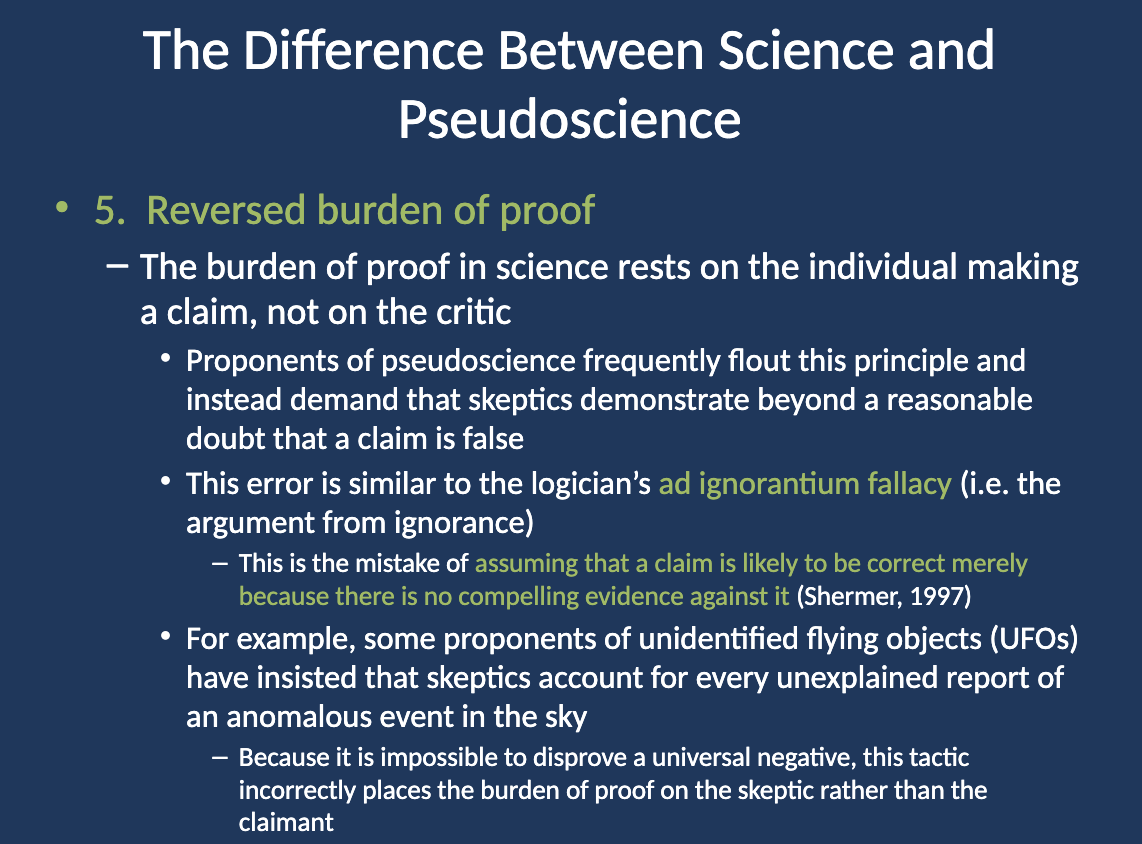
What is the 6th major difference between science and pseudoscience? (The Difference Between Science and Pseudoscience)
[Note: Not explicitly listed in your text, but commonly included is:] Lack of connectivity with existing knowledge—pseudoscience often ignores established scientific findings instead of building upon them.
What is the 7th major difference between science and pseudoscience? (The Difference Between Science and Pseudoscience)
Overreliance on testimonial and anecdotal evidence—while useful for hypothesis generation, anecdotes are weak evidence for hypothesis testing and are often misleading.
What does overreliance on testimonial and anecdotal evidence mean? (The Difference Between Science and Pseudoscience)
Overreliance on testimonial and anecdotal evidence refers to the excessive use of personal stories or individual accounts to support claims. While such evidence can be compelling, it is not always scientifically valid or reliable, especially in the absence of broader, controlled studies.
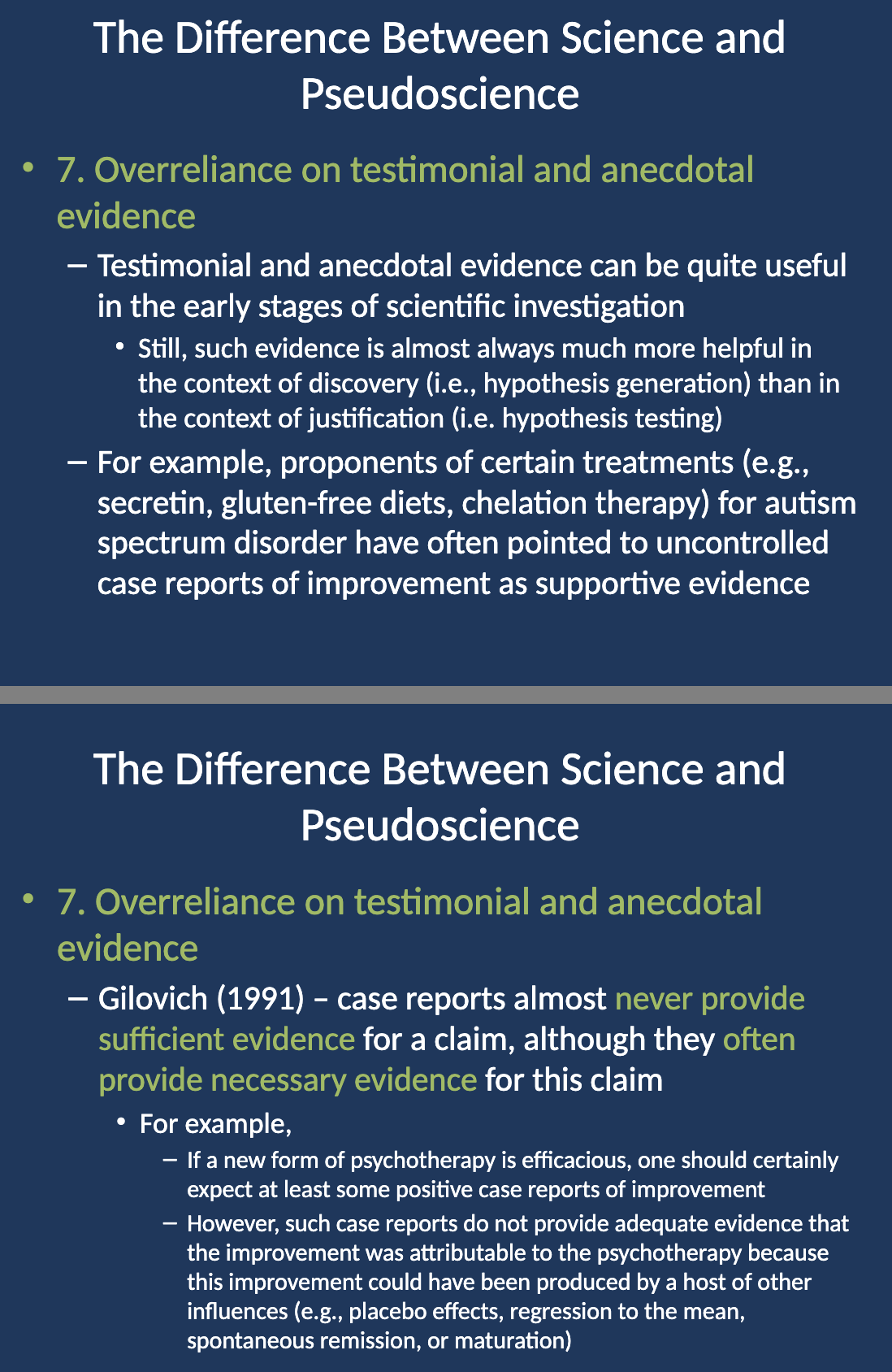
Why is testimonial and anecdotal evidence useful but not more helpful in certain contexts? (The Difference Between Science and Pseudoscience)
Testimonial and anecdotal evidence can be useful in the early stages of scientific investigation, especially for generating hypotheses. However, it is not as helpful in justifying or validating a claim because it lacks the control and rigor needed for hypothesis testing.

Can you provide an example that explains why testimonial and anecdotal evidence can be unreliable in science? (The Difference Between Science and Pseudoscience)
Proponents of treatments like secretin, gluten-free diets, and chelation therapy for autism spectrum disorder often cite uncontrolled case reports where patients appear to improve. While these individual reports are important for generating hypotheses, they cannot provide reliable evidence that the treatments caused the improvement, as other factors like placebo effects or regression to the mean could be at play.
What did Gilovich (1991) find regarding case reports in scientific claims? (The Difference Between Science and Pseudoscience)
Gilovich (1991) found that case reports almost never provide sufficient evidence to support a claim, although they are often necessary for generating hypotheses. For example, if a new psychotherapy is thought to be effective, positive case reports would be expected. However, these reports do not prove the therapy's effectiveness because the observed improvements could be due to other factors, such as placebo effects or maturation.
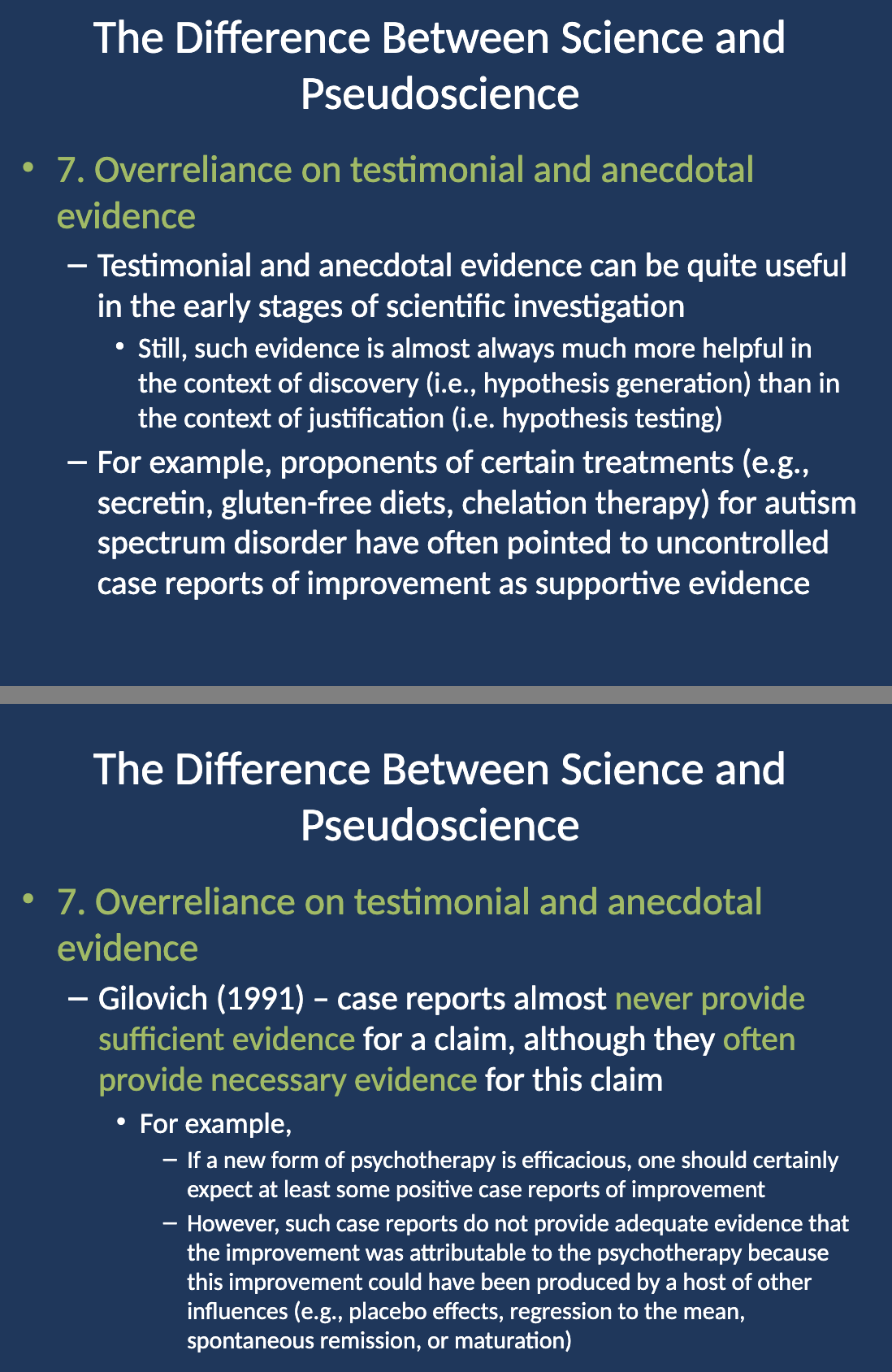
Why are anecdotal claims problematic in pseudoscience? (The Difference Between Science and Pseudoscience)
Because they are uncontrolled and subjective, they are not reliable evidence for the effectiveness of treatments, yet they are often treated as proof (e.g., in autism treatments like secretin or chelation therapy).
What is the 8th major difference between science and pseudoscience? (The Difference Between Science and Pseudoscience)
Use of obscurantist language—pseudoscientific proponents often use complex, technical-sounding jargon to give their ideas a false appearance of scientific legitimacy (e.g., EMDR's explanation using terms like “valences of neural receptors”).
What does "obscurantist language" refer to in pseudoscience? (The Difference Between Science and Pseudoscience)
Obscurantist language refers to the use of impressive-sounding, highly technical jargon or complex terminology to give the appearance of scientific legitimacy. Proponents of pseudoscience often use this type of language to make their claims seem more credible or scientific, even though the terms may be vague or lack clear meaning.
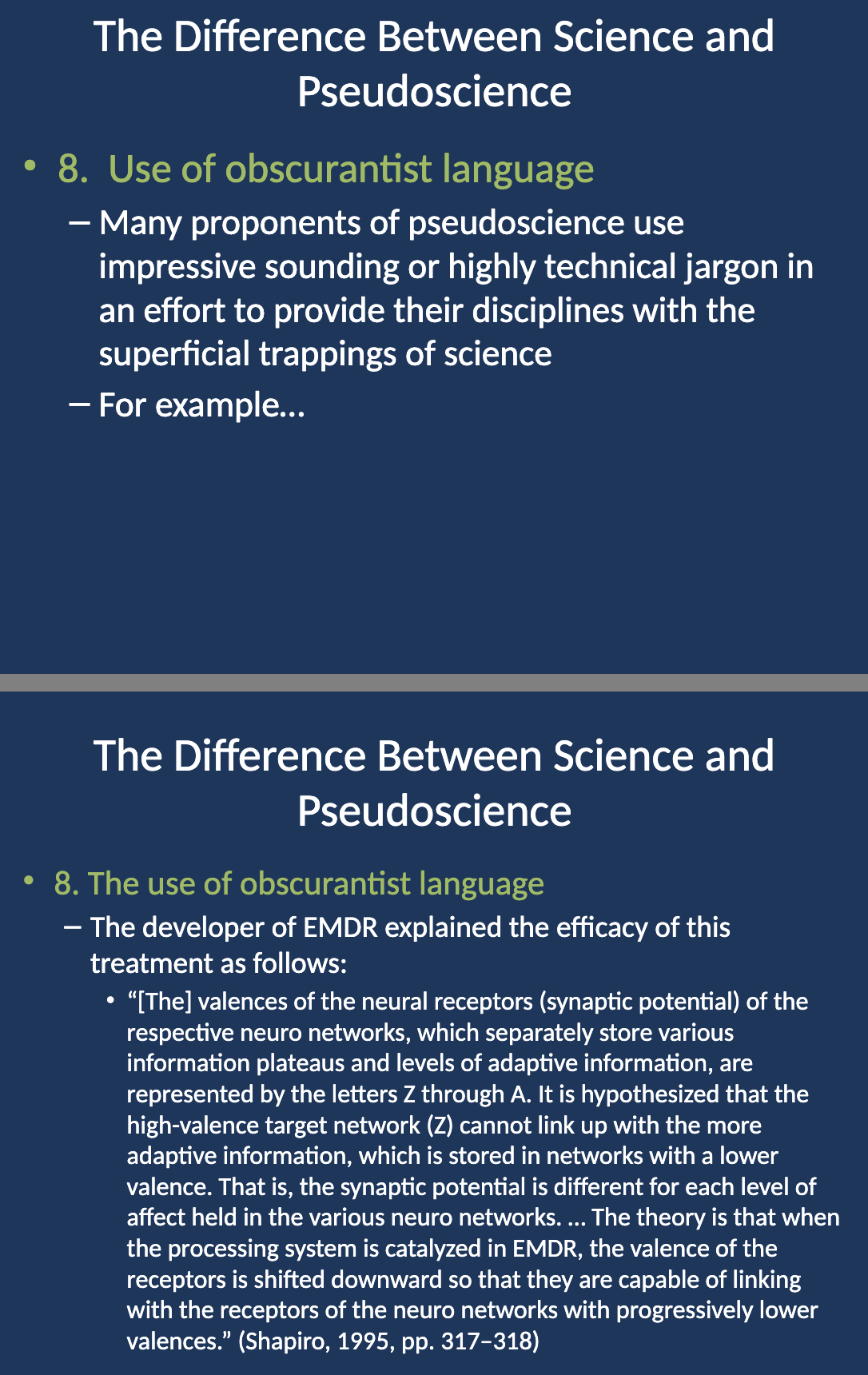
Can you provide an example of obscurantist language in pseudoscience? (The Difference Between Science and Pseudoscience)
A developer of EMDR (Eye Movement Desensitization and Reprocessing) treatment explained its efficacy using highly complex language:
Example:
"[The] valences of the neural receptors (synaptic potential) of the respective neuro networks, which separately store various information plateaus and levels of adaptive information, are represented by the letters Z through A. It is hypothesized that the high-valence target network (Z) cannot link up with the more adaptive information, which is stored in networks with a lower valence. That is, the synaptic potential is different for each level of affect held in the various neuro networks… The theory is that when the processing system is catalyzed in EMDR, the valence of the receptors is shifted downward so that they are capable of linking with the receptors of the neuro networks with progressively lower valences." (Shapiro, 1995, pp. 317–318)
This convoluted explanation uses obscurantist language to make the treatment sound scientifically plausible, even though it lacks clarity and clear empirical support.
![<p>A developer of EMDR (Eye Movement Desensitization and Reprocessing) treatment explained its efficacy using highly complex language:</p><p>Example:</p><p>"[The] valences of the neural receptors (synaptic potential) of the respective neuro networks, which separately store various information plateaus and levels of adaptive information, are represented by the letters Z through A. It is hypothesized that the high-valence target network (Z) cannot link up with the more adaptive information, which is stored in networks with a lower valence. That is, the synaptic potential is different for each level of affect held in the various neuro networks… The theory is that when the processing system is catalyzed in EMDR, the valence of the receptors is shifted downward so that they are capable of linking with the receptors of the neuro networks with progressively lower valences." (Shapiro, 1995, pp. 317–318)</p><p>This convoluted explanation uses obscurantist language to make the treatment sound scientifically plausible, even though it lacks clarity and clear empirical support.</p>](https://knowt-user-attachments.s3.amazonaws.com/320d7b0f-6517-43a6-a00d-0c020c75affb.png)
What is the 9th major difference between science and pseudoscience? (The Difference Between Science and Pseudoscience)
Absence of boundary conditions—scientific theories define limits for when and where they apply, but pseudoscientific claims often assert universal effectiveness (e.g., Thought Field Therapy claimed to work on nearly all mental disorders and even animals).
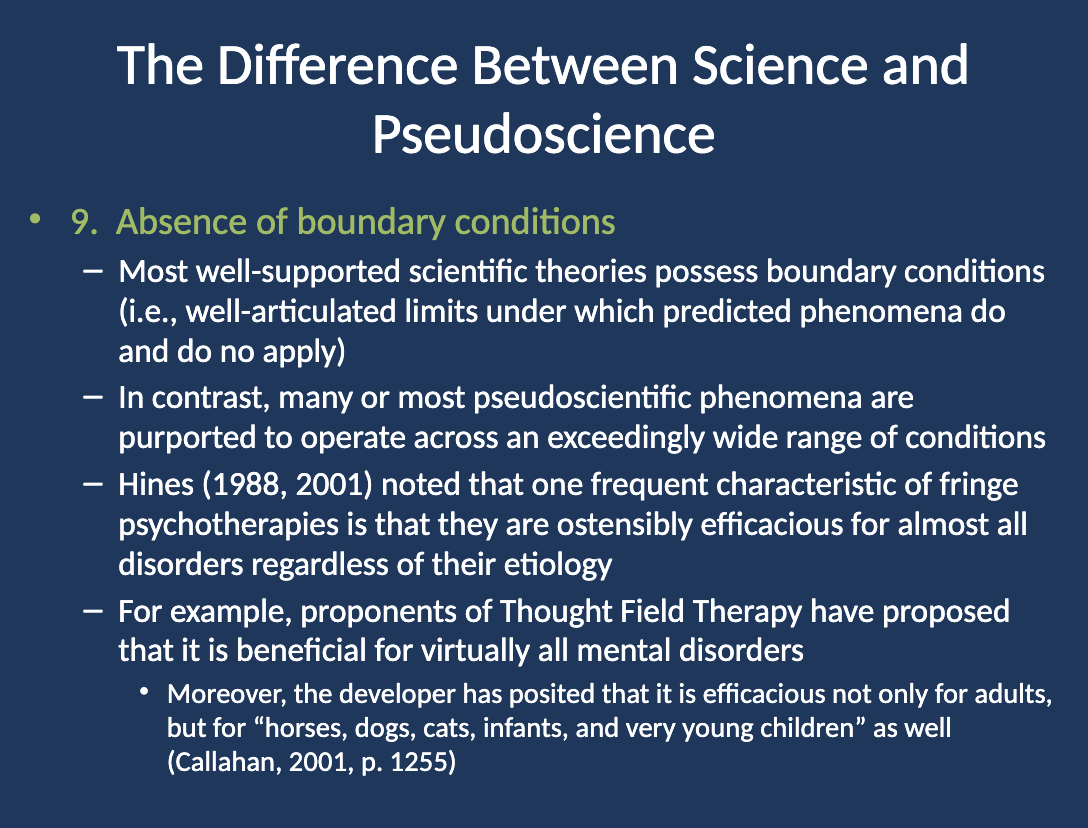
What does "absence of boundary conditions" mean in pseudoscience? (The Difference Between Science and Pseudoscience)
Absence of boundary conditions means that pseudoscientific claims often lack well-defined limits under which they can be proven true or false. In contrast, scientific theories have clear boundaries that specify when and where predictions apply and don’t apply.
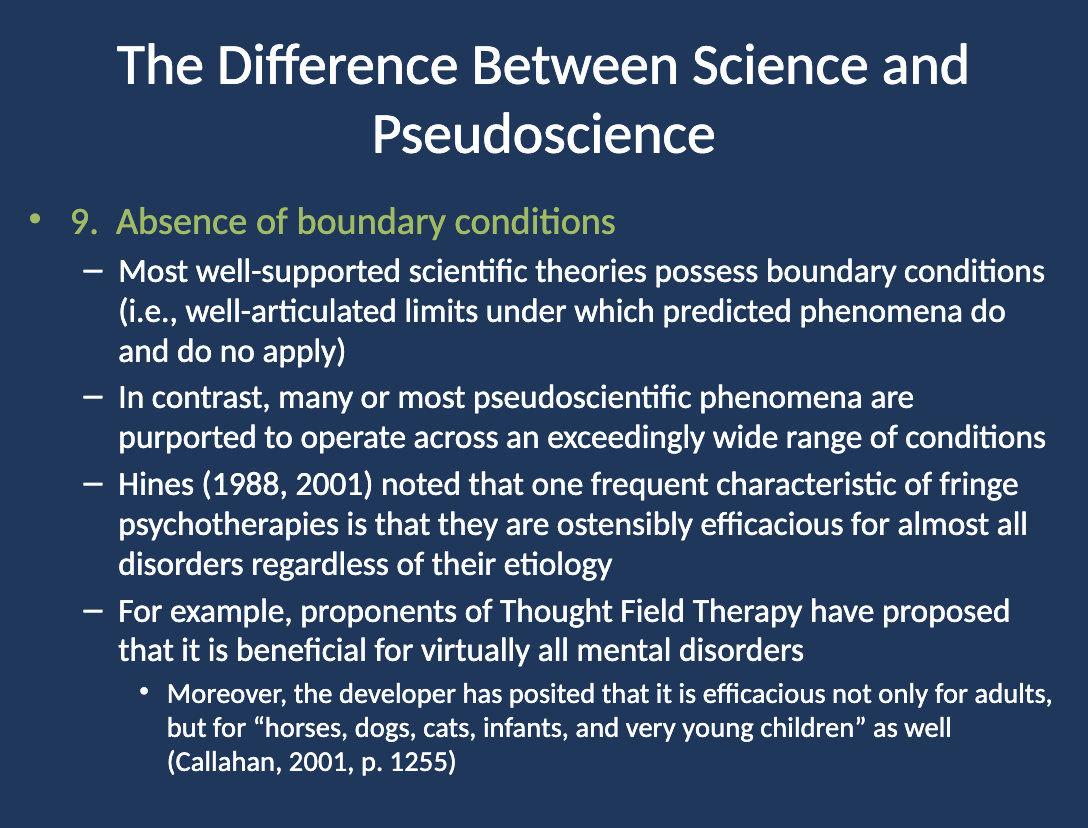
How do most well-supported scientific theories differ from pseudoscientific phenomena in terms of boundary conditions? (The Difference Between Science and Pseudoscience)
Most well-supported scientific theories have boundary conditions, meaning they clearly define the limits under which their predictions are valid. In contrast, pseudoscientific claims tend to apply across an overly broad range of conditions without any limitations, making them more difficult to test or falsify.

What is in contrast to the absence of boundary conditions in pseudoscience? (The Difference Between Science and Pseudoscience)
In contrast, well-supported scientific theories have boundary conditions that specify the situations in which their predictions hold true. Pseudoscience often lacks these boundaries, making its claims more flexible and harder to evaluate.

What did Hines (1988, 2001) note about fringe psychotherapies? (The Difference Between Science and Pseudoscience)
Hines noted that fringe psychotherapies (like many pseudosciences) often claim to be effective for almost all disorders, regardless of their cause or etiology. This lack of specificity further exemplifies the absence of boundary conditions in pseudoscientific fields.
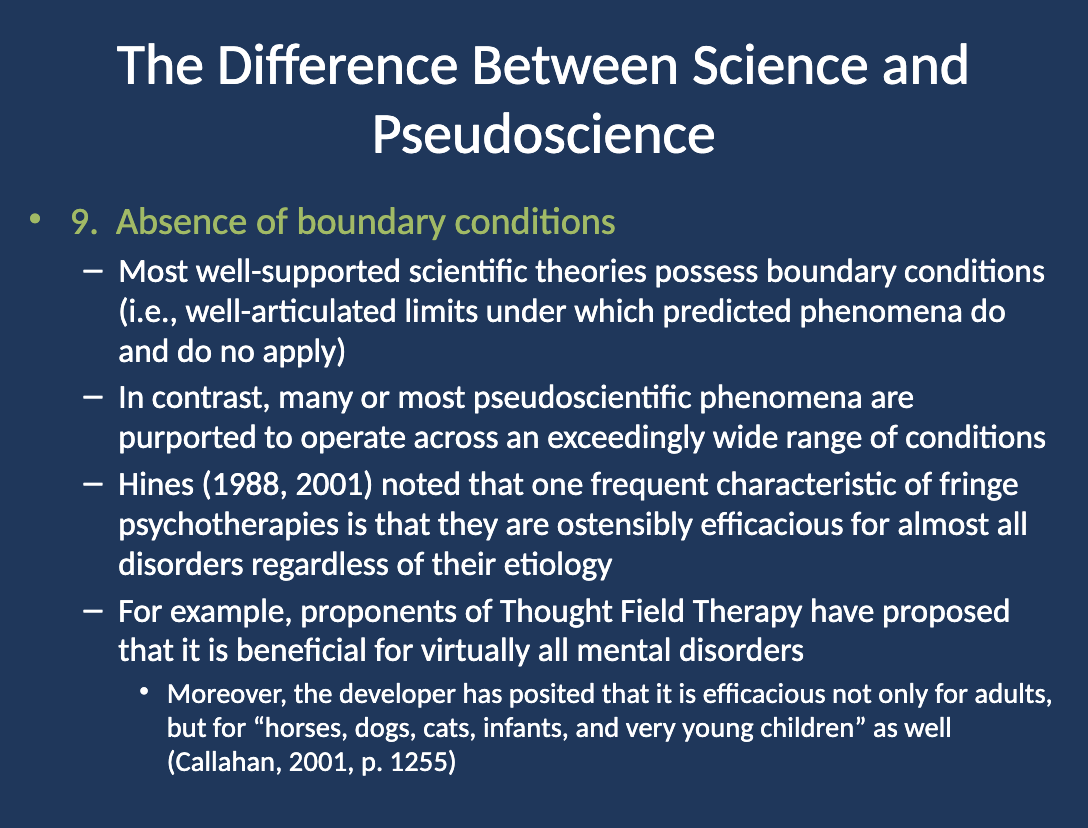
Can you provide an example of a pseudoscientific claim about absence of boundary conditions? (The Difference Between Science and Pseudoscience)
Thought Field Therapy (TFT) claims to be effective for virtually all mental disorders, regardless of their cause. The developer of TFT has even suggested that it works for adults, horses, dogs, cats, infants, and young children alike (Callahan, 2001). This broad application with no clear limitations shows the absence of boundary conditions.

What is the 10th major difference between science and pseudoscience? (The Difference Between Science and Pseudoscience)
The mantra of holism—pseudoscientists often argue that claims can only be evaluated within broad, complex contexts, using this as an excuse to dismiss negative findings and avoid falsification (e.g., defending Rorschach test results by claiming they are never interpreted alone).
What does the mantra of holism in pseudoscience explain away? (The Difference Between Science and Pseudoscience)
The mantra of holism in pseudoscience is used to explain away negative findings. Proponents argue that scientific claims should be evaluated only within the context of broader claims, so findings cannot be judged in isolation.
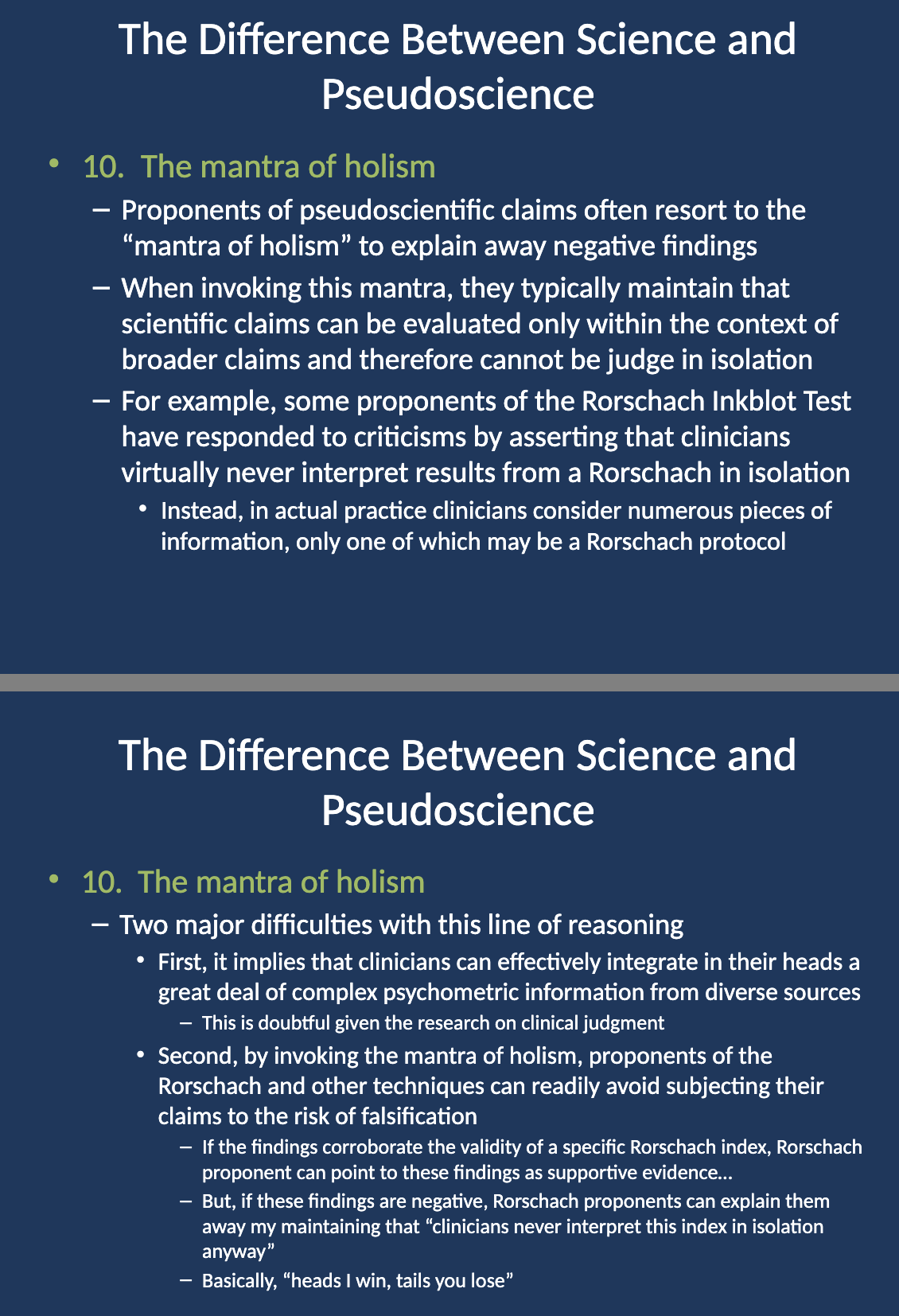
How does the mantra of holism work in practice to avoid criticism? (The Difference Between Science and Pseudoscience)
Proponents of pseudoscience, like the Rorschach Inkblot Test, use the mantra of holism to avoid criticism by arguing that clinicians never interpret results in isolation. Instead, they consider numerous other pieces of information, making it hard to pinpoint flaws in the method or interpretation.
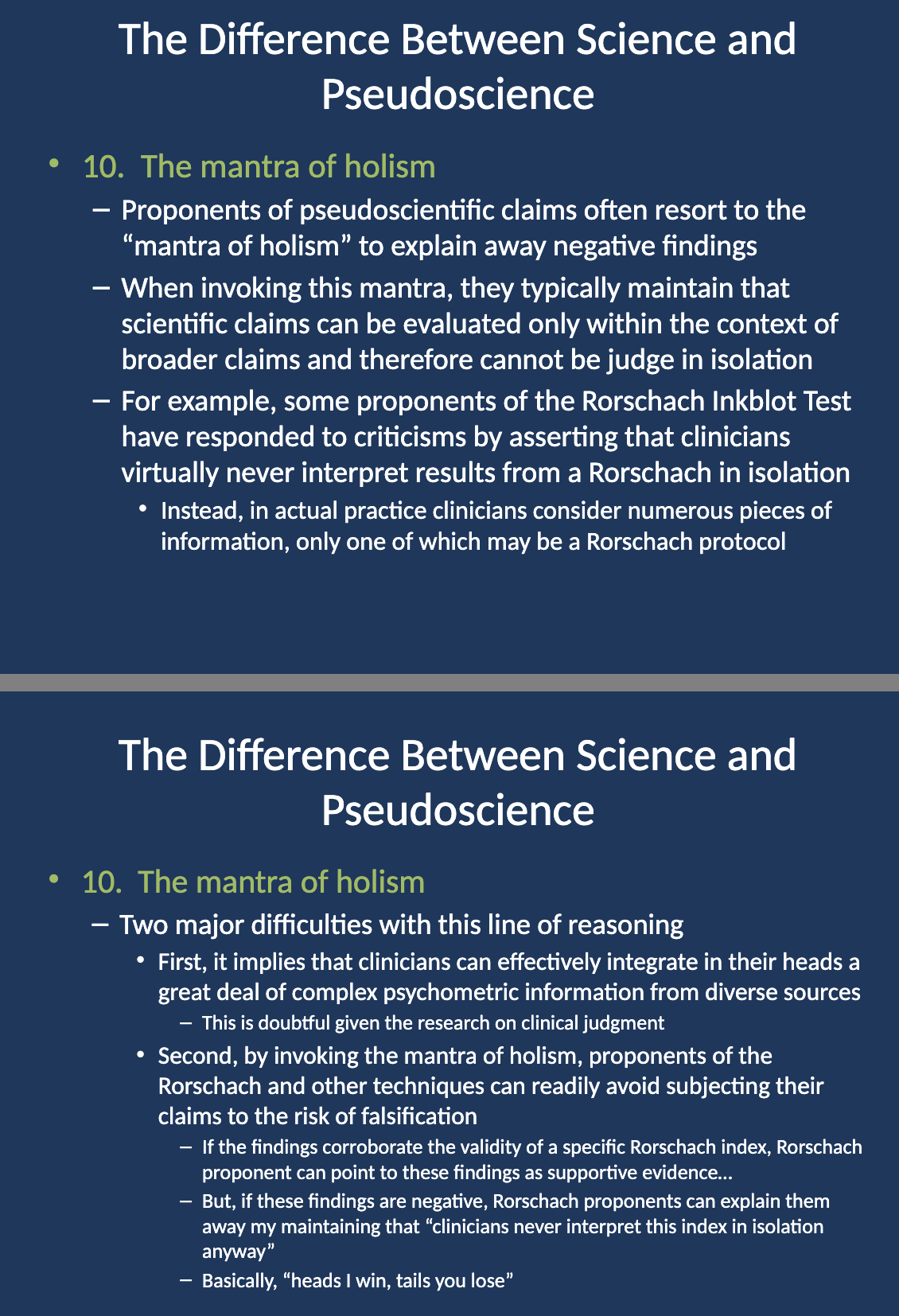
What are the two major difficulties with the mantra of holism? (The Difference Between Science and Pseudoscience)
First difficulty: It assumes clinicians can effectively integrate a large amount of complex information from diverse sources, which is doubtful given research on clinical judgment.
Second difficulty: The mantra allows proponents to avoid falsification by explaining away negative findings. If the findings support the claim, they are seen as evidence, but if they contradict it, proponents simply argue that claims cannot be judged in isolation.

What is the first difficulty with the mantra of holism? (The Difference Between Science and Pseudoscience)
The first difficulty is that it assumes clinicians can effectively integrate complex psychometric information from many sources. However, research on clinical judgment suggests this is unlikely to be true, making this approach problematic.
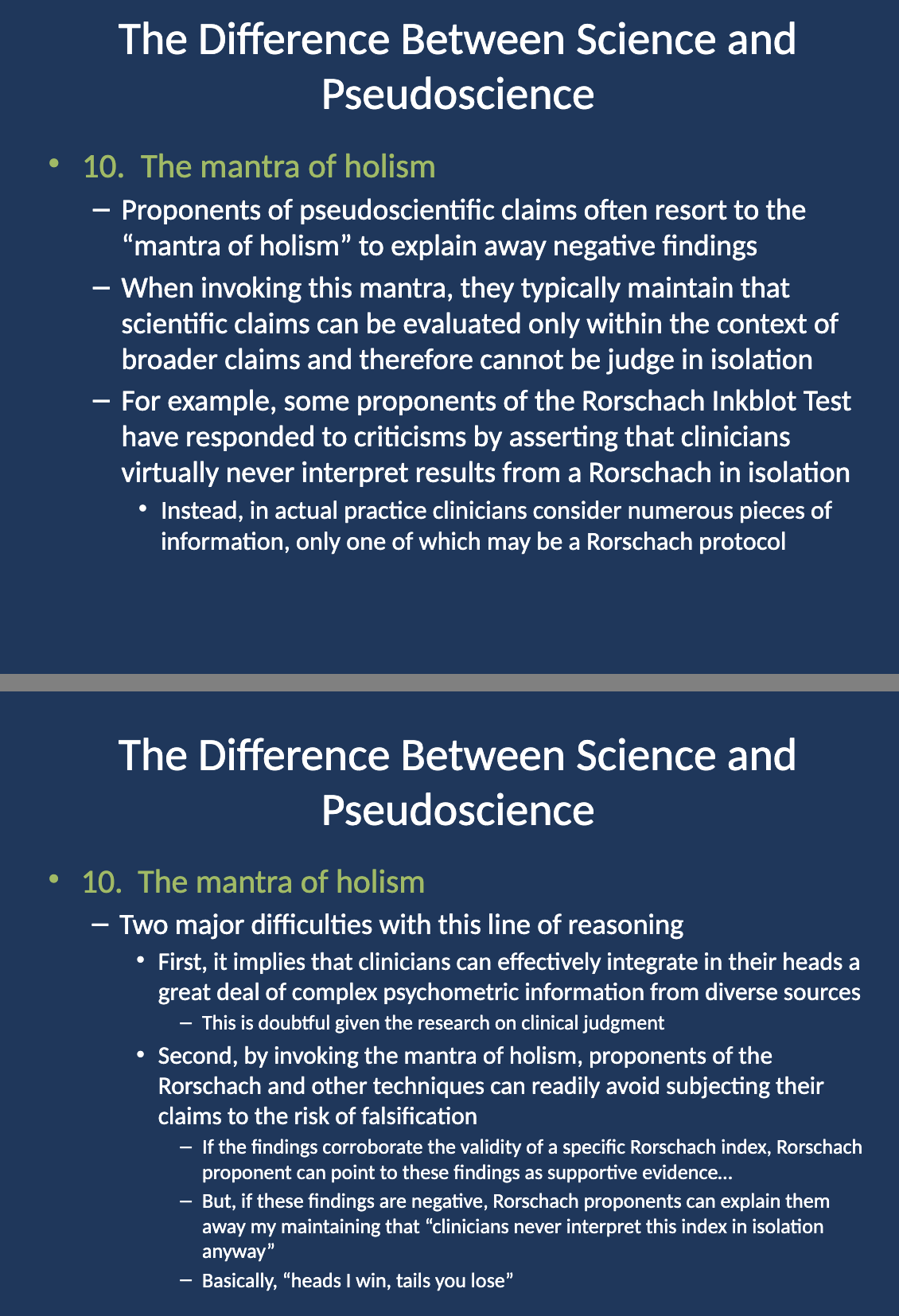
What is the second difficulty with the mantra of holism? (The Difference Between Science and Pseudoscience)
The second difficulty is that it allows proponents of pseudoscientific claims to avoid falsification. They can explain negative findings by claiming that their method (e.g., Rorschach) isn’t supposed to be interpreted in isolation, thus avoiding the risk of disproving their theory.
